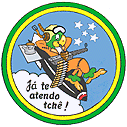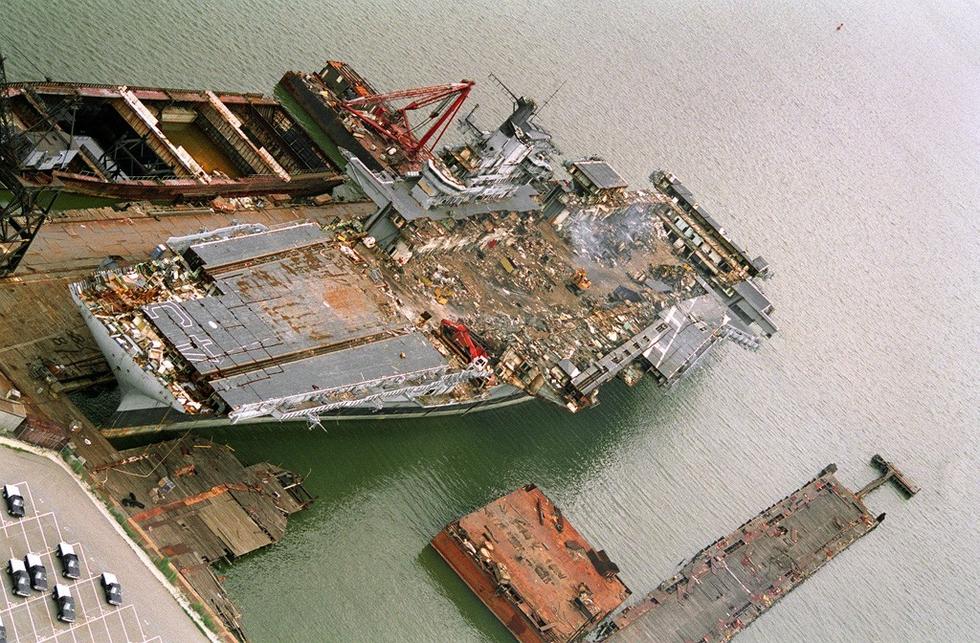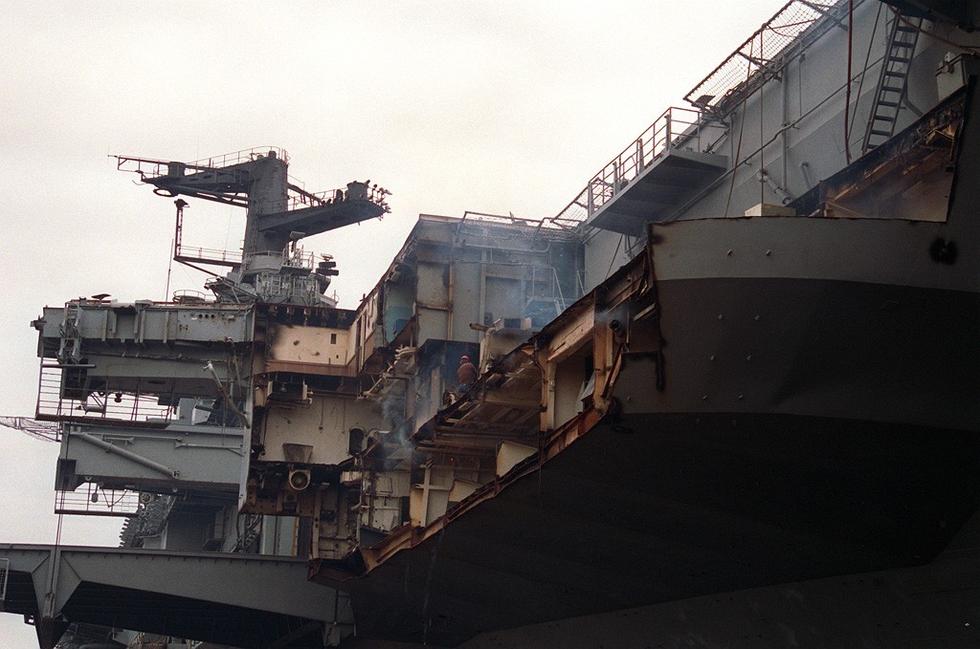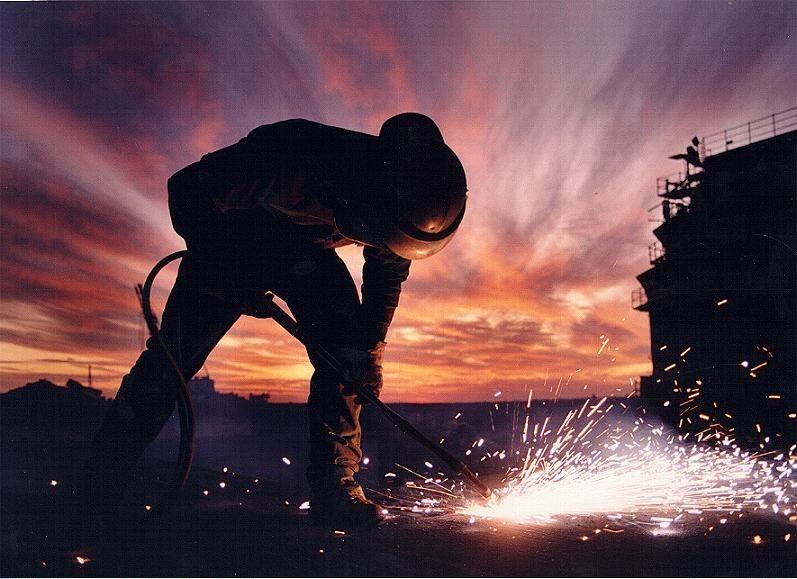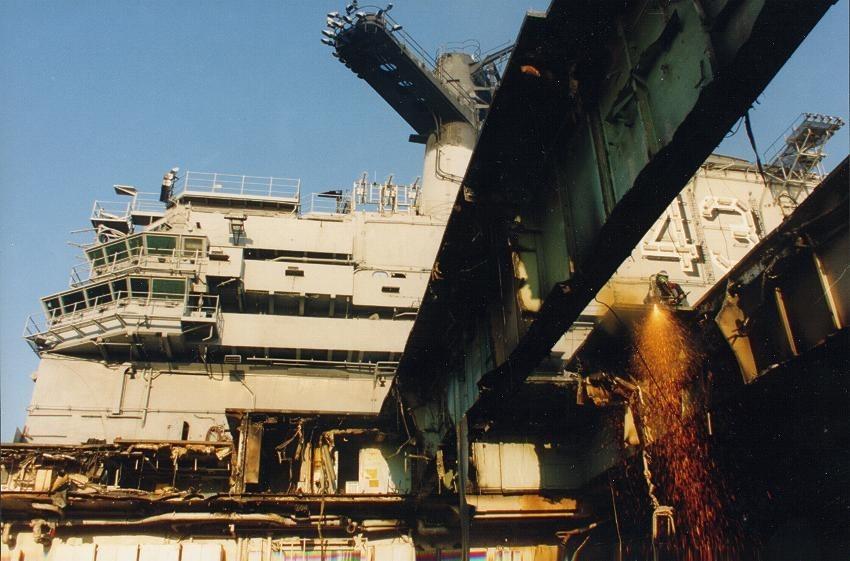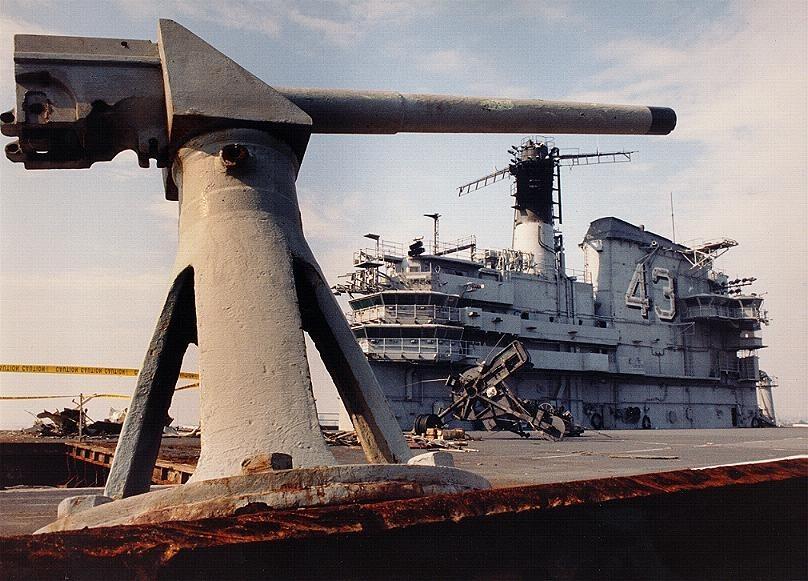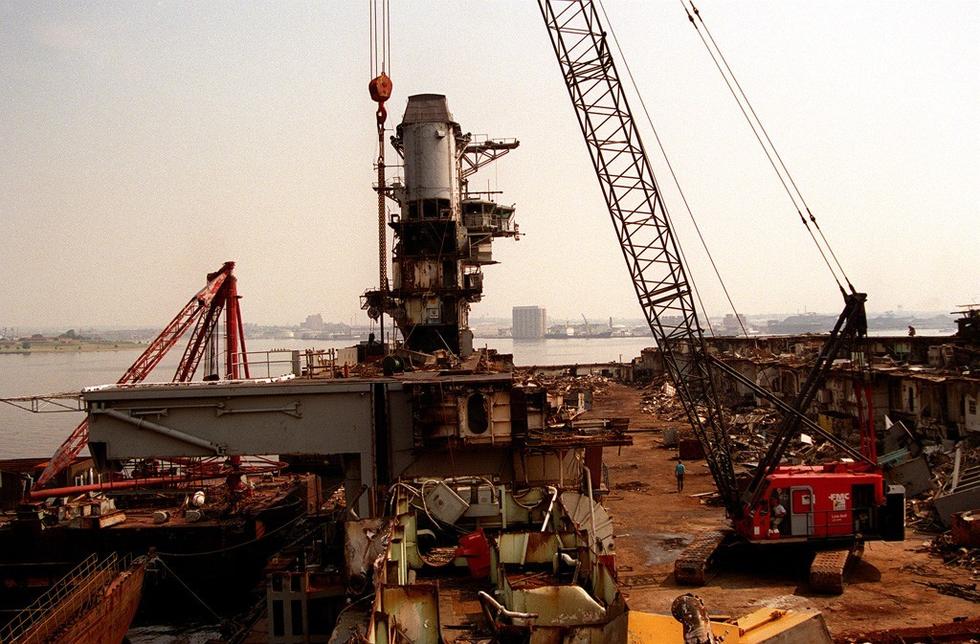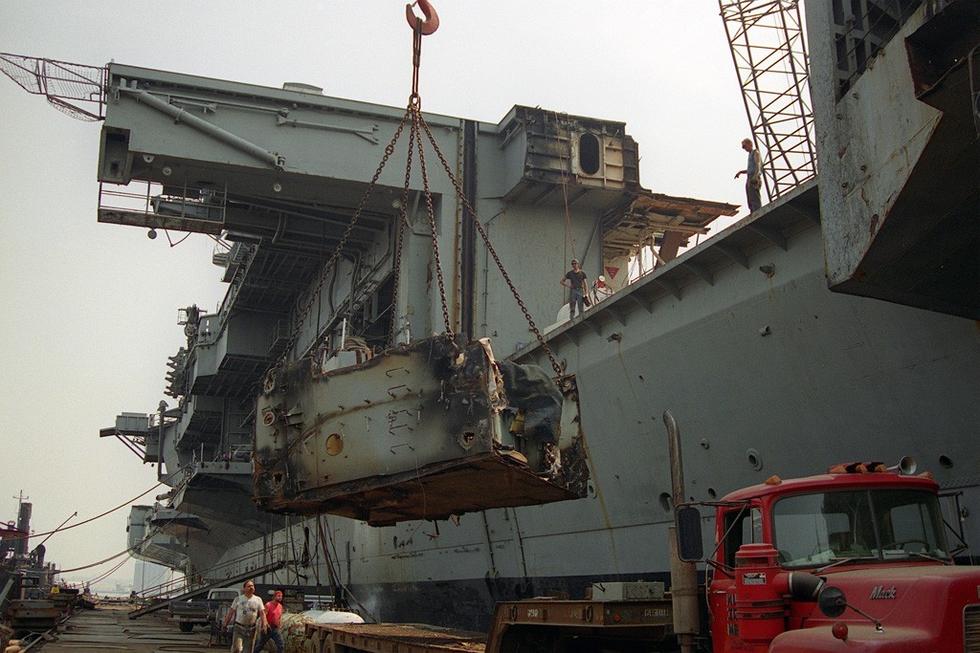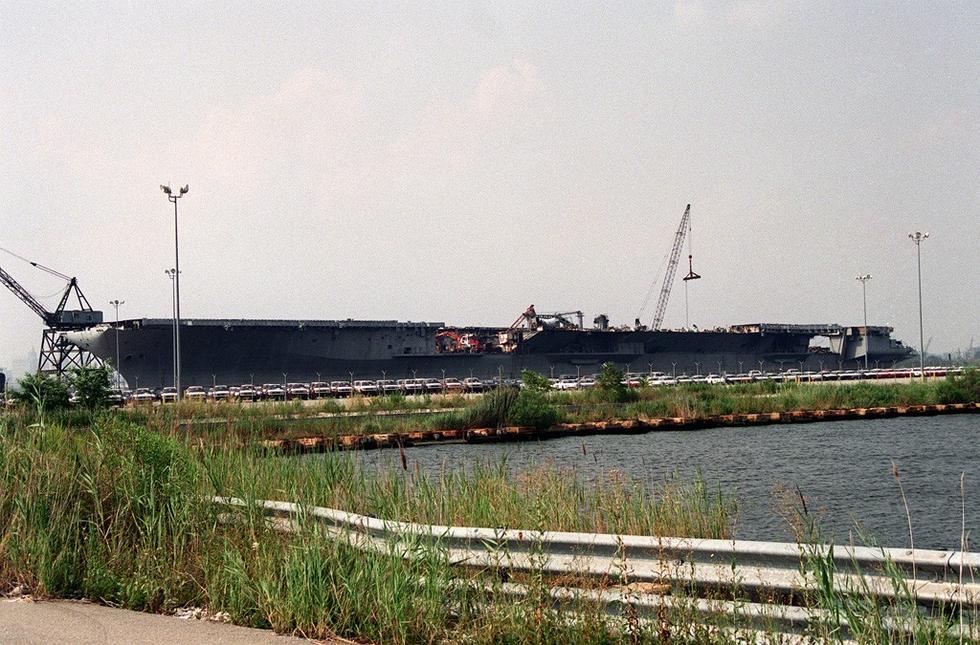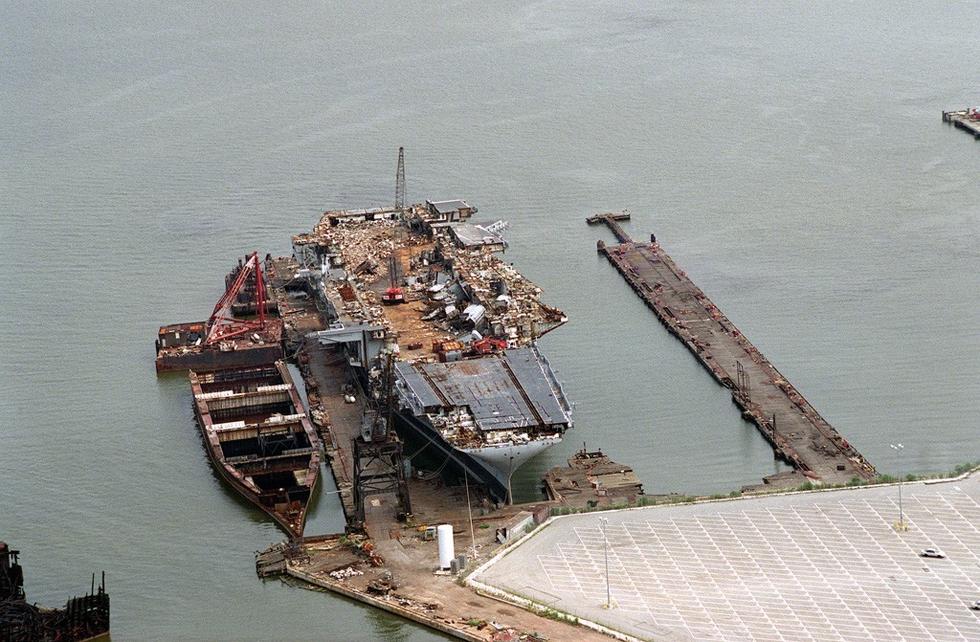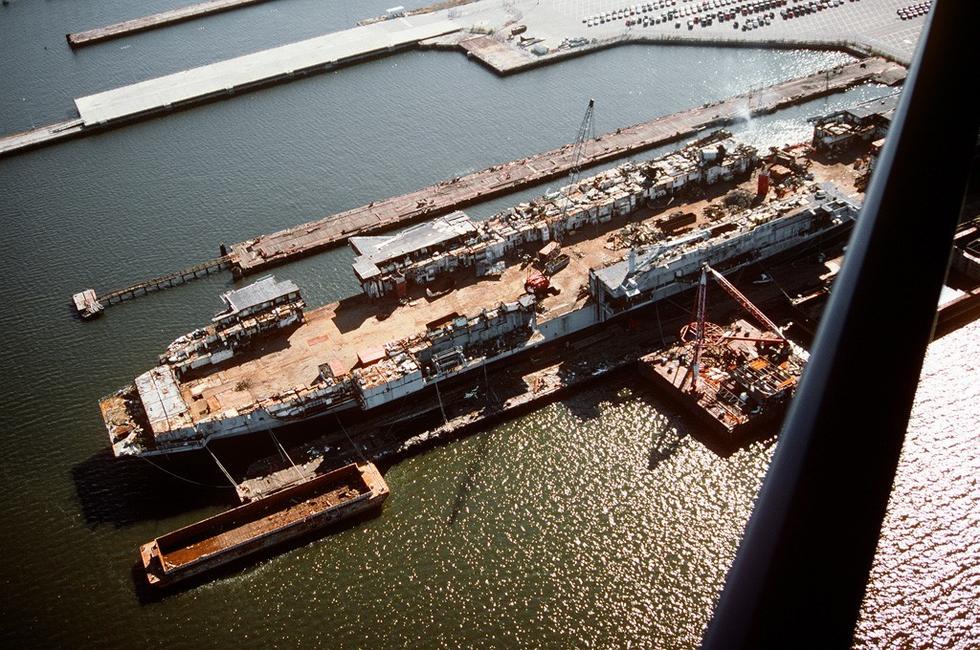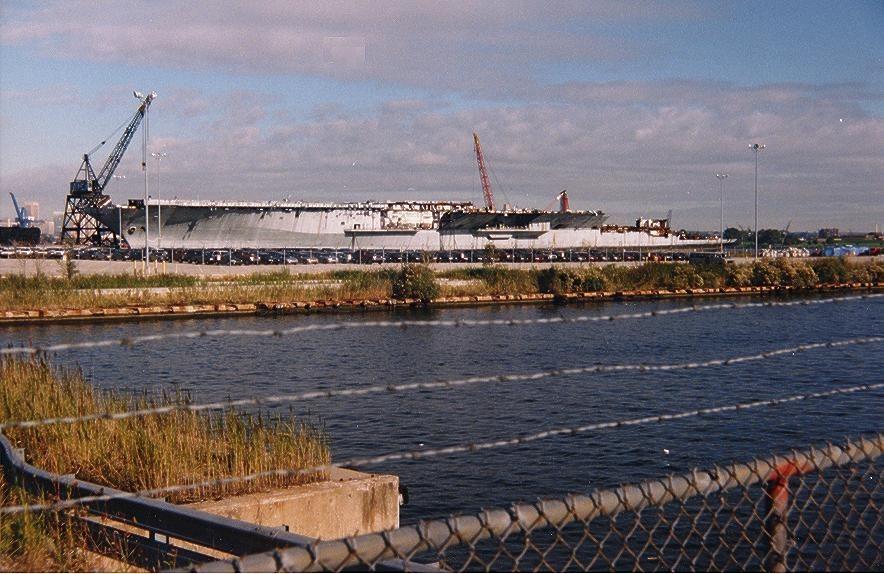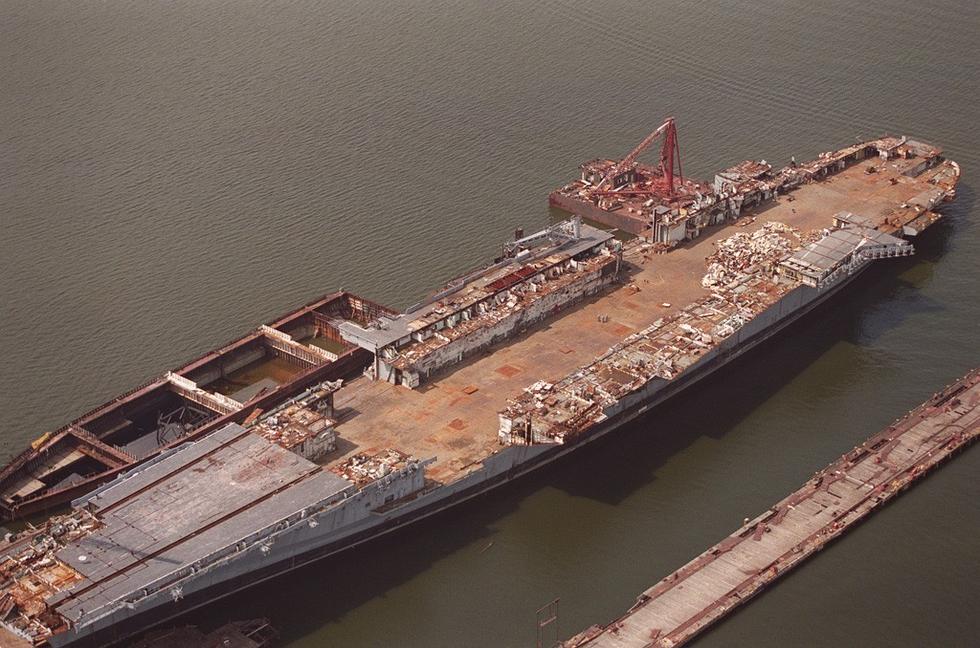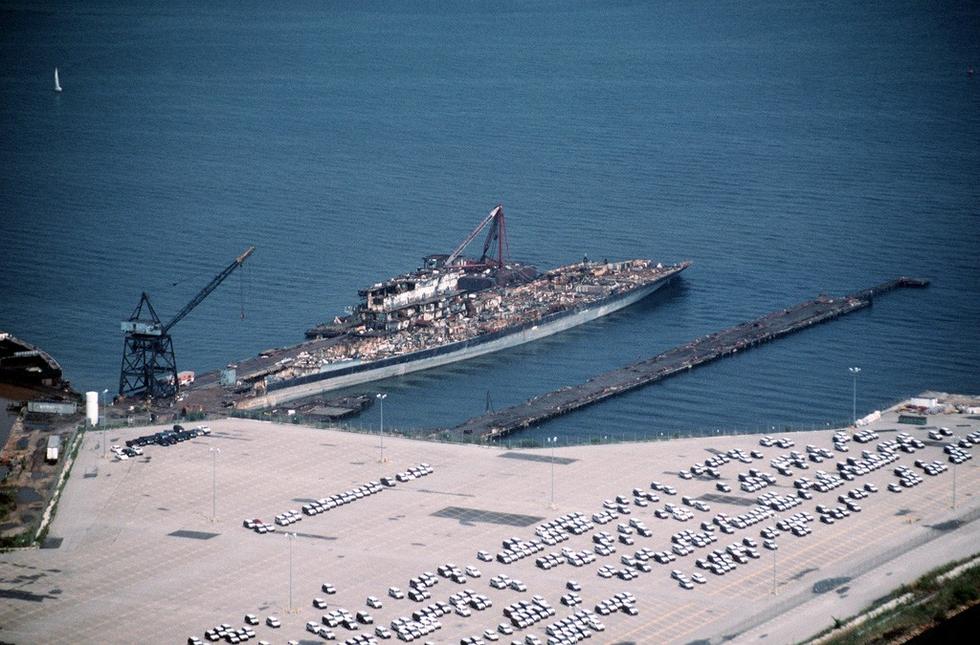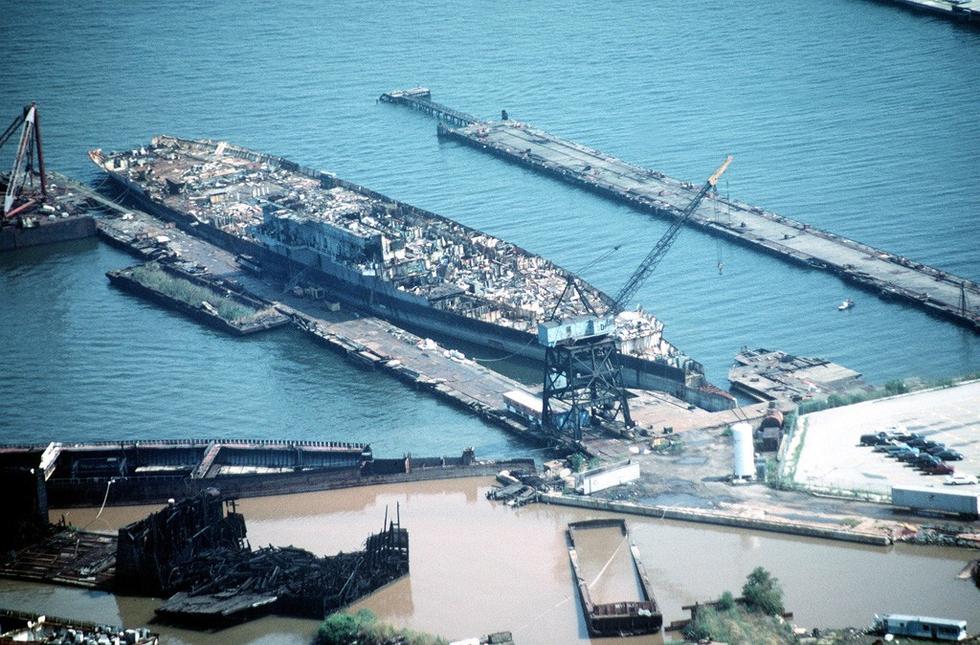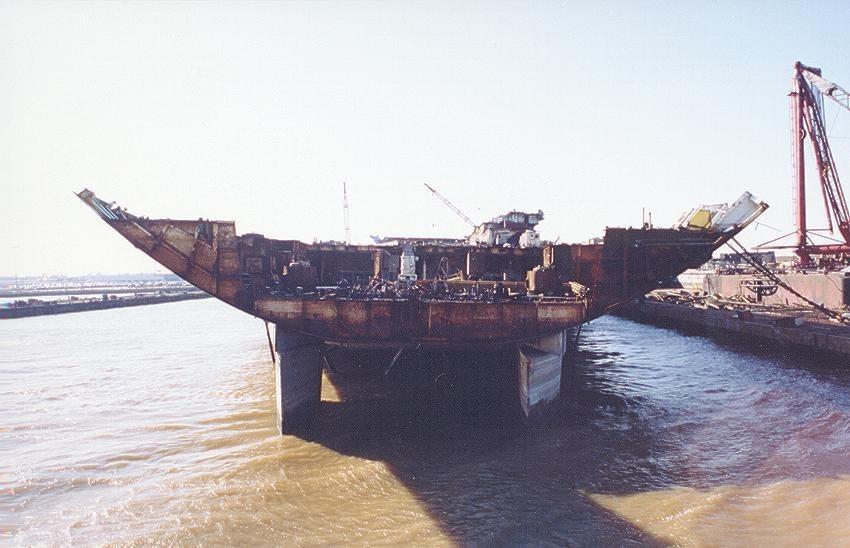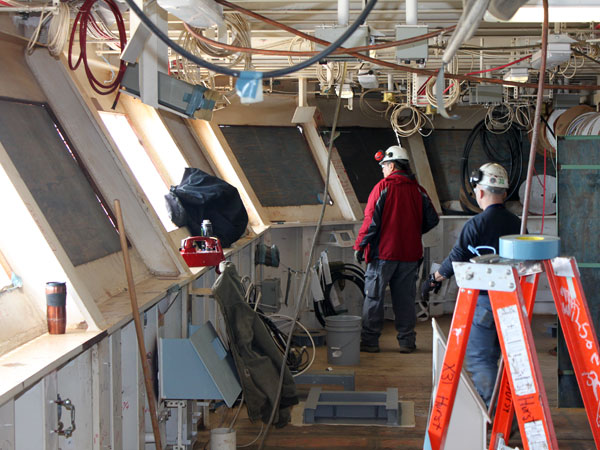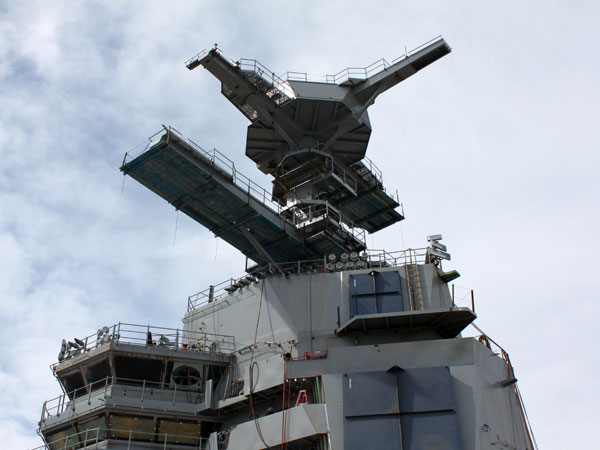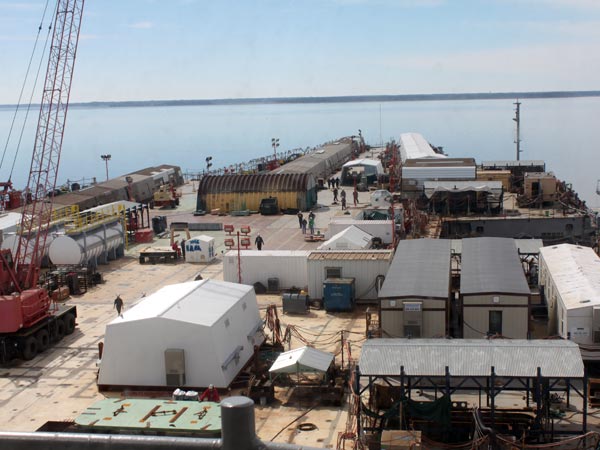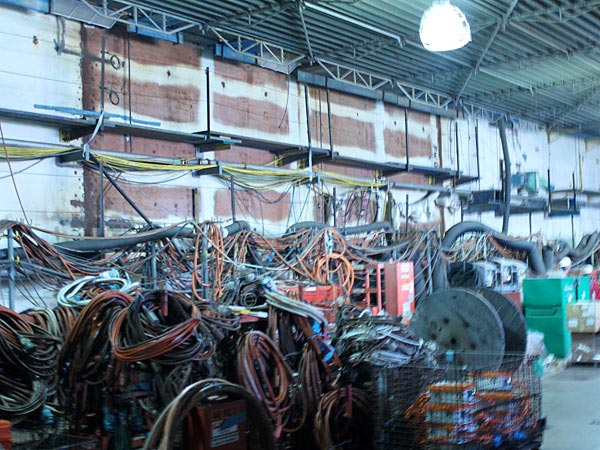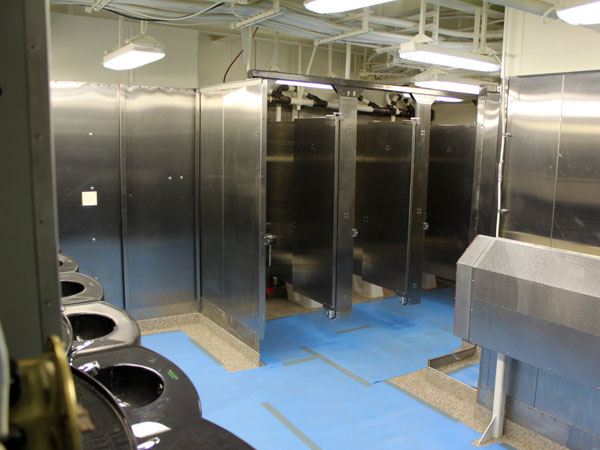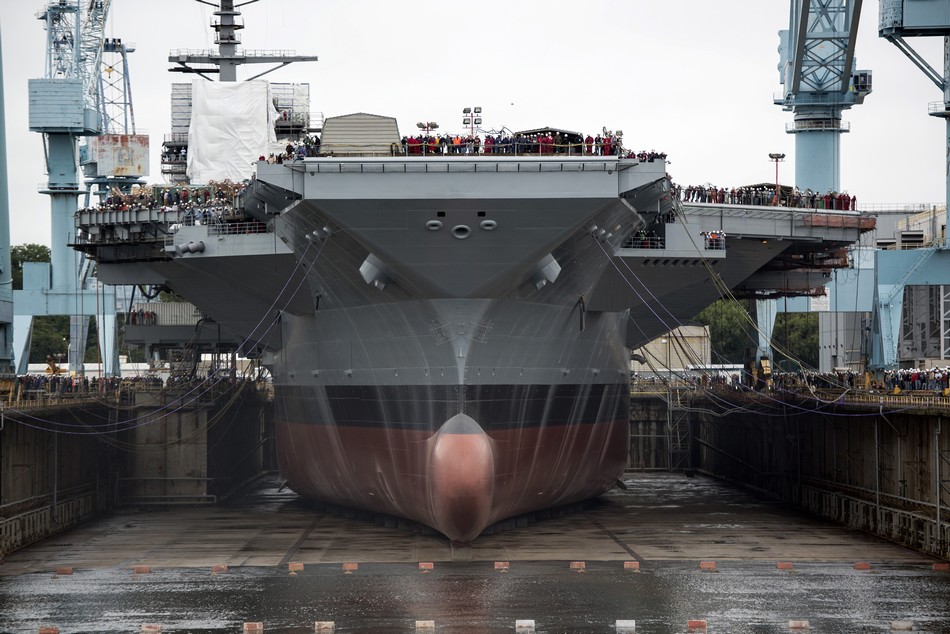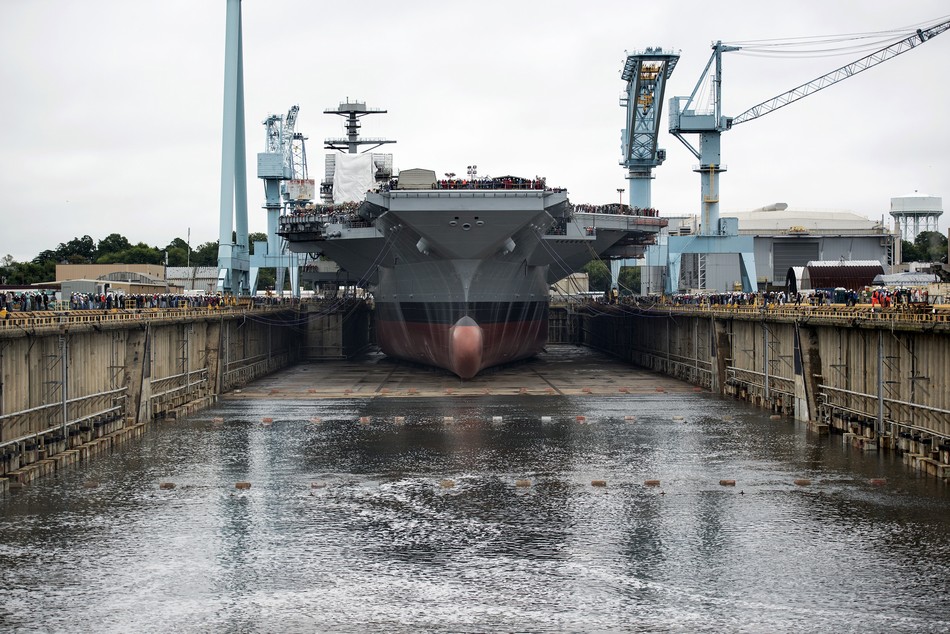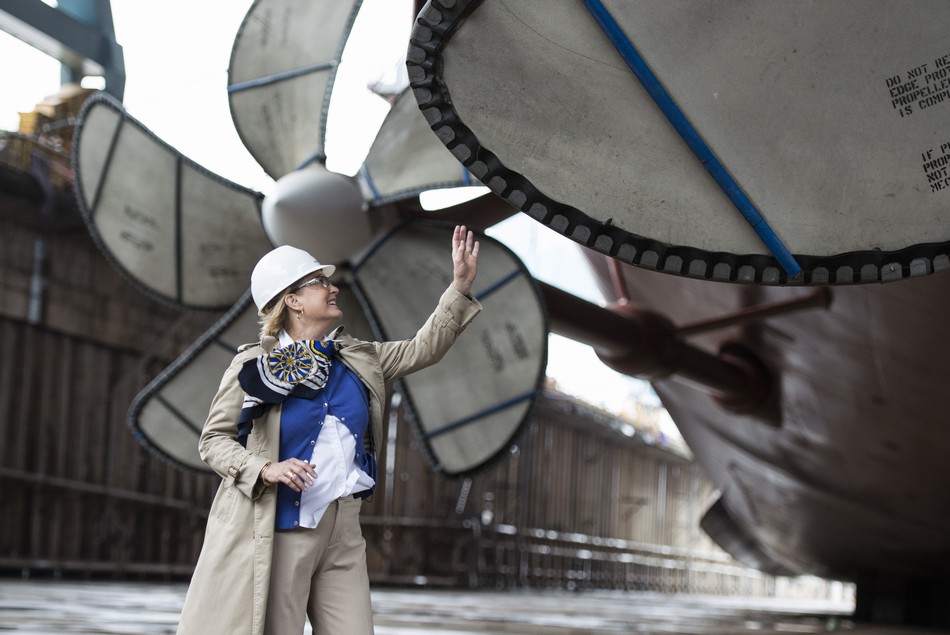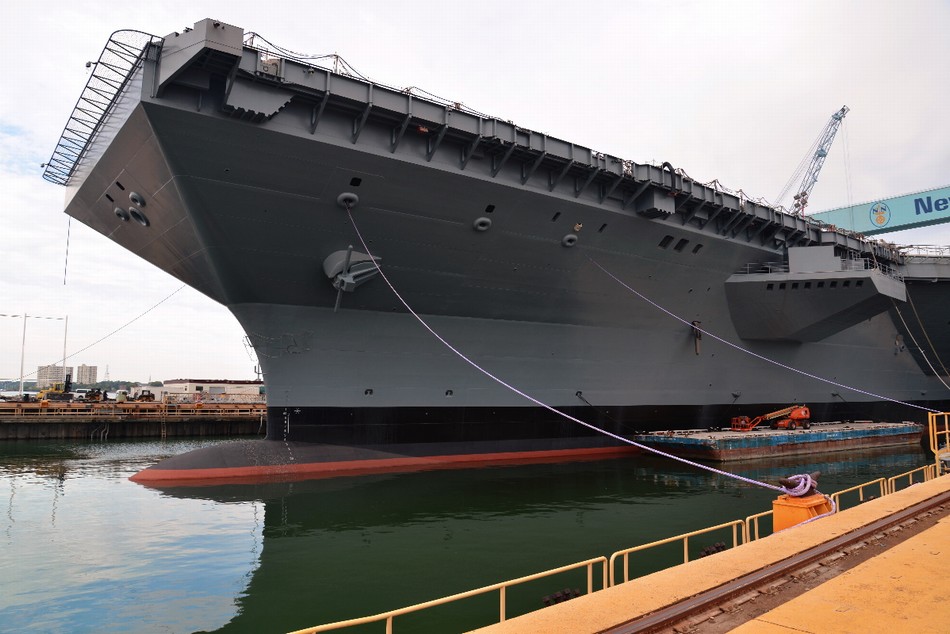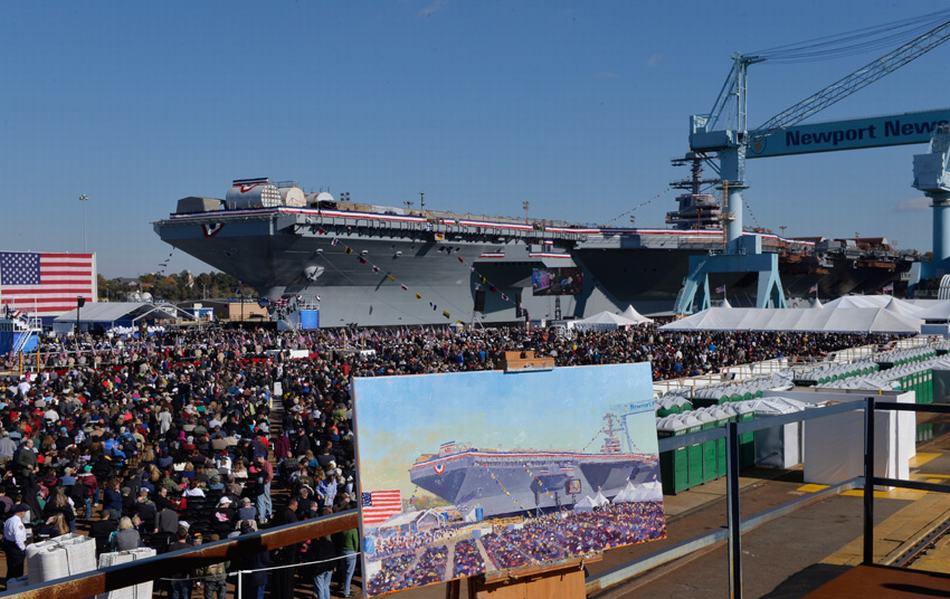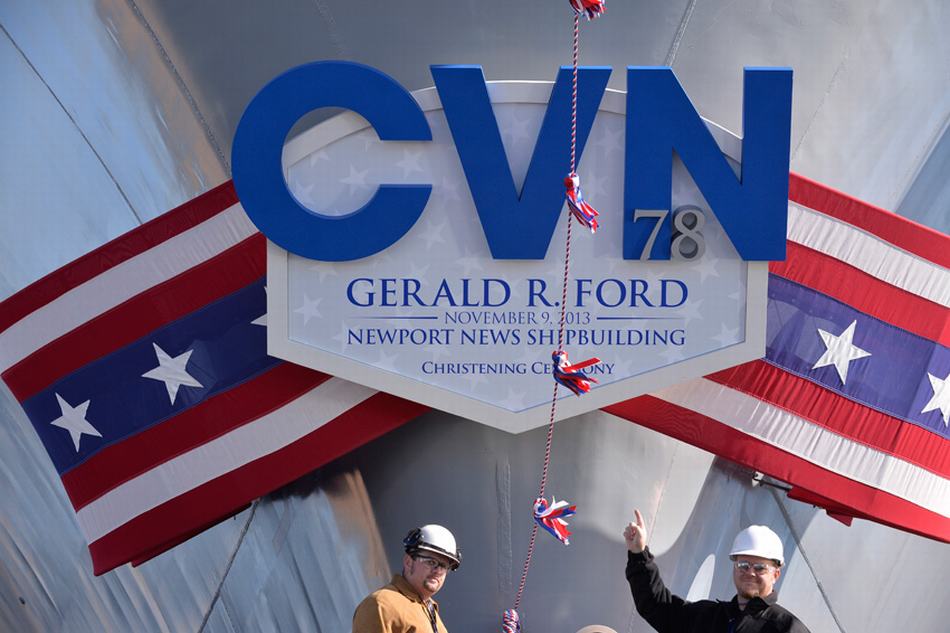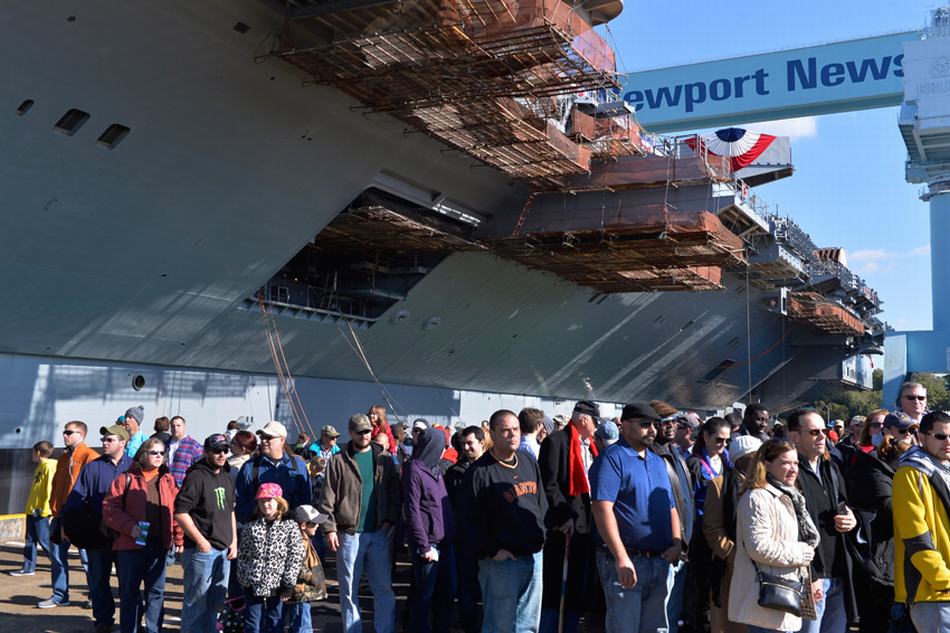Marinha dos EUA
Moderador: Conselho de Moderação
- jambockrs
- Sênior

- Mensagens: 2617
- Registrado em: Sex Jun 10, 2005 1:45 am
- Localização: Porto Alegre/RS
- Agradeceu: 427 vezes
- Agradeceram: 180 vezes
Re: Marinha dos EUA
Meus prezados
JHSV-1 USNS Spearhead: que espécie de nave é o Spearhead? É o caminhão de carga marítimo da marinha americana.
JHSV-1 USNS Spearhead: que espécie de nave é o Spearhead? É o caminhão de carga marítimo da marinha americana.
- P44
- Sênior

- Mensagens: 55189
- Registrado em: Ter Dez 07, 2004 6:34 am
- Localização: O raio que vos parta
- Agradeceu: 2739 vezes
- Agradeceram: 2410 vezes
- P44
- Sênior

- Mensagens: 55189
- Registrado em: Ter Dez 07, 2004 6:34 am
- Localização: O raio que vos parta
- Agradeceu: 2739 vezes
- Agradeceram: 2410 vezes
Re: Marinha dos EUA

The USS Zumwalt (DDG 1000) and the USS Monsoor (DDG 1001) berthed together.
Triste sina ter nascido português 
- akivrx78
- Sênior

- Mensagens: 6354
- Registrado em: Dom Fev 08, 2009 8:16 am
- Agradeceu: 104 vezes
- Agradeceram: 326 vezes
Re: Marinha dos EUA
Lockheed Martin Demonstrates LRASM’s Surface Launch Capabilities
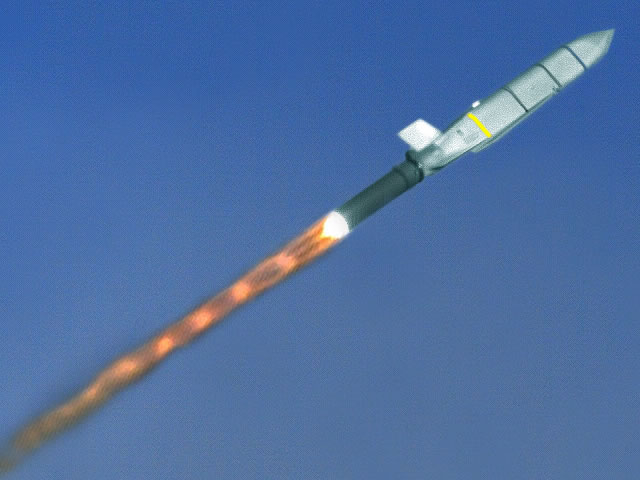
Lockheed Martin recently conducted a successful controlled flight test of the Long Range Anti-Ship Missile (LRASM) surface-launch variant from the Self Defense Test Ship at Pt. Mugu Sea Range, California.
Archive Lockheed Martin picture: Successful boosted test vehicle flight demonstrating LRASM missile egress, flight with existing Mk-114 ASROCK booster and Mk-41 VLS canister design.
This was the third successful surface-launched LRASM test, proving the missile’s ability to load mission data using the modified Tactical Tomahawk Weapon Control System (TTWCS+), align mission data with the moving ship and launch from the MK 41 Vertical Launch System (VLS). During the test, LRASM exited the VLS launcher, cleanly separated from its Mk-114 booster and transitioned to the cruise phase. The missile successfully flew a pre-planned low-altitude profile collecting aerodynamics agility data while enroute to its pre-determined endpoint.
“This successful flight test demonstrates Lockheed Martin’s readiness to answer the U.S. Navy’s need for new anti-surface warfare capabilities as part of the ‘distributed lethality’ concept,” said Scott Callaway, LRASM Surface-Launch director at Lockheed Martin Missiles and Fire Control. “This LRASM flight test from a U.S. Navy surface ship VLS highlights the successful collaboration between Lockheed Martin and the U.S. Navy.”
To support this test, Lockheed Martin invested internal funds to provide an operational LRASM and to refurbish the Navy’s Self Defense Test Ship MK 41 VLS. This demonstration from a moving ship in a dynamic at-sea environment was a critical step in proving the maturity of the surface-launch variant. LRASM was also tested successfully from a ground-based MK 41 VLS “Desert Ship” in 2013 and 2014. Integrating LRASM with the VLS will provide every Aegis destroyer and cruiser with a long-range, survivable anti-surface warfare distributed lethality capability.
The surface-launch LRASM variant was built on the same production line as JASSM, JASSM-ER and LRASM air-launch weapons, and delivers the same long-range, precision capability. With maturity of the MK 41 VLS integration demonstrated, Lockheed Martin will continue testing on other surface ship applications, including topside, deck-mounted launchers.
http://www.youtube.com/watch?v=3MuaaFhSoZc
Video: Interview on LRASM during Sea Air Space 2016
The first vertical launched LRASM test took place in September 2014.
Navy Recognition reported during the SNA show in January that LRASM could potentially come with land attack capability. While this capability is not part of the current (OASuW increment I) set of requirements (increment II requirements have not been released yet), we were told that a software update would provide LRASM with such capability. This is because LRASM is based on the AGM-158 JASSM (Joint Air-to-Surface Standoff Missile) standoff land attack cruise missile.
The LRASM is a long-range subsonic cruise missile designed for better range and survivability than current anti-ship weaponry. This missile development program is a joint effort of the Defense Advanced Research Projects Agency, Naval Air Systems Command and the United States Air Force.
To learn more: Link to LRASM Long Range Anti-Ship Missile technical datasheet

Lockheed Martin recently conducted a successful controlled flight test of the Long Range Anti-Ship Missile (LRASM) surface-launch variant from the Self Defense Test Ship at Pt. Mugu Sea Range, California.
Archive Lockheed Martin picture: Successful boosted test vehicle flight demonstrating LRASM missile egress, flight with existing Mk-114 ASROCK booster and Mk-41 VLS canister design.
This was the third successful surface-launched LRASM test, proving the missile’s ability to load mission data using the modified Tactical Tomahawk Weapon Control System (TTWCS+), align mission data with the moving ship and launch from the MK 41 Vertical Launch System (VLS). During the test, LRASM exited the VLS launcher, cleanly separated from its Mk-114 booster and transitioned to the cruise phase. The missile successfully flew a pre-planned low-altitude profile collecting aerodynamics agility data while enroute to its pre-determined endpoint.
“This successful flight test demonstrates Lockheed Martin’s readiness to answer the U.S. Navy’s need for new anti-surface warfare capabilities as part of the ‘distributed lethality’ concept,” said Scott Callaway, LRASM Surface-Launch director at Lockheed Martin Missiles and Fire Control. “This LRASM flight test from a U.S. Navy surface ship VLS highlights the successful collaboration between Lockheed Martin and the U.S. Navy.”
To support this test, Lockheed Martin invested internal funds to provide an operational LRASM and to refurbish the Navy’s Self Defense Test Ship MK 41 VLS. This demonstration from a moving ship in a dynamic at-sea environment was a critical step in proving the maturity of the surface-launch variant. LRASM was also tested successfully from a ground-based MK 41 VLS “Desert Ship” in 2013 and 2014. Integrating LRASM with the VLS will provide every Aegis destroyer and cruiser with a long-range, survivable anti-surface warfare distributed lethality capability.
The surface-launch LRASM variant was built on the same production line as JASSM, JASSM-ER and LRASM air-launch weapons, and delivers the same long-range, precision capability. With maturity of the MK 41 VLS integration demonstrated, Lockheed Martin will continue testing on other surface ship applications, including topside, deck-mounted launchers.
http://www.youtube.com/watch?v=3MuaaFhSoZc
Video: Interview on LRASM during Sea Air Space 2016
The first vertical launched LRASM test took place in September 2014.
Navy Recognition reported during the SNA show in January that LRASM could potentially come with land attack capability. While this capability is not part of the current (OASuW increment I) set of requirements (increment II requirements have not been released yet), we were told that a software update would provide LRASM with such capability. This is because LRASM is based on the AGM-158 JASSM (Joint Air-to-Surface Standoff Missile) standoff land attack cruise missile.
The LRASM is a long-range subsonic cruise missile designed for better range and survivability than current anti-ship weaponry. This missile development program is a joint effort of the Defense Advanced Research Projects Agency, Naval Air Systems Command and the United States Air Force.
To learn more: Link to LRASM Long Range Anti-Ship Missile technical datasheet
- akivrx78
- Sênior

- Mensagens: 6354
- Registrado em: Dom Fev 08, 2009 8:16 am
- Agradeceu: 104 vezes
- Agradeceram: 326 vezes
Re: Marinha dos EUA
USSOCOM to Use New Lockheed Martin Undersea Vehicle for Long-Distance Missions

Lockheed Martin, in partnership with Submergence Group LLC, will manufacture Dry Combat Submersibles (DCS) that will transport personnel to their mission sites while submerged. These vehicles have longer endurance and operate at greater depths than swimmer delivery vehicles (SDV) in use. Lockheed Martin’s Dry Combat Submersible delivers personnel to and from their missions. Photo courtesy Lockheed Martin.
Under the terms of the $166 million U.S. Special Operations Command (USSOCOM) contract, Lockheed Martin will build as many as three DCS vehicles over the next five years. The vehicles will weigh more than 30 tons, be launched from surface ships, and be able to travel long distances underwater.
Currently, personnel transiting underwater use the SDV to reach their final destination – the personnel are in dive gear and exposed to the undersea environment. DCS allows the personnel to get closer to their destination before they enter the water, and be more effective upon arrival.
“Our advancements in undersea technologies will ensure personnel are equipped with technologically capable and adaptable systems that can easily be refreshed with the latest capabilities,” said Erika Marshall, general manager and program director at Lockheed Martin’s site in Palm Beach. “These reliable undersea vehicles will protect personnel, ensure they arrive ready to execute their mission, and return them safely.”
With over 50 years of manned submersible experience, Lockheed Martin continues to advance undersea submersible technology to improve inspection and combat capability, while assuring operational safety.
Lockheed Martin is partnered with Submergence Group, LLC to build, integrate, test, and deliver up to three submersibles to USSOCOM. Work will be performed in Plymouth, United Kingdom, and Palm Beach County, Florida.
Lockheed Martin, in partnership with Submergence Group LLC, will manufacture Dry Combat Submersibles (DCS) that will transport personnel to their mission sites while submerged. These vehicles have longer endurance and operate at greater depths than swimmer delivery vehicles (SDV) in use.
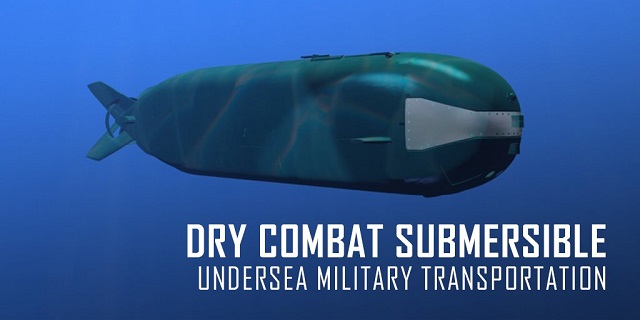
Lockheed Martin’s Dry Combat Submersible delivers personnel to and from their missions. Photo courtesy Lockheed Martin.

Lockheed Martin, in partnership with Submergence Group LLC, will manufacture Dry Combat Submersibles (DCS) that will transport personnel to their mission sites while submerged. These vehicles have longer endurance and operate at greater depths than swimmer delivery vehicles (SDV) in use. Lockheed Martin’s Dry Combat Submersible delivers personnel to and from their missions. Photo courtesy Lockheed Martin.
Under the terms of the $166 million U.S. Special Operations Command (USSOCOM) contract, Lockheed Martin will build as many as three DCS vehicles over the next five years. The vehicles will weigh more than 30 tons, be launched from surface ships, and be able to travel long distances underwater.
Currently, personnel transiting underwater use the SDV to reach their final destination – the personnel are in dive gear and exposed to the undersea environment. DCS allows the personnel to get closer to their destination before they enter the water, and be more effective upon arrival.
“Our advancements in undersea technologies will ensure personnel are equipped with technologically capable and adaptable systems that can easily be refreshed with the latest capabilities,” said Erika Marshall, general manager and program director at Lockheed Martin’s site in Palm Beach. “These reliable undersea vehicles will protect personnel, ensure they arrive ready to execute their mission, and return them safely.”
With over 50 years of manned submersible experience, Lockheed Martin continues to advance undersea submersible technology to improve inspection and combat capability, while assuring operational safety.
Lockheed Martin is partnered with Submergence Group, LLC to build, integrate, test, and deliver up to three submersibles to USSOCOM. Work will be performed in Plymouth, United Kingdom, and Palm Beach County, Florida.
Lockheed Martin, in partnership with Submergence Group LLC, will manufacture Dry Combat Submersibles (DCS) that will transport personnel to their mission sites while submerged. These vehicles have longer endurance and operate at greater depths than swimmer delivery vehicles (SDV) in use.

Lockheed Martin’s Dry Combat Submersible delivers personnel to and from their missions. Photo courtesy Lockheed Martin.
- P44
- Sênior

- Mensagens: 55189
- Registrado em: Ter Dez 07, 2004 6:34 am
- Localização: O raio que vos parta
- Agradeceu: 2739 vezes
- Agradeceram: 2410 vezes
Re: Marinha dos EUA
https://ukdefencejournal.org.uk/new-ame ... ign=socialThe US Navy’s newest supercarrier, the USS Gerald R. Ford, may struggle to launch and recover aircraft, mount a defence and move munitions.
It has been reported that on-board systems for the previously mentioned tasks have poor or unknown reliability issues, according to a June the 28th memo obtained by Bloomberg News.
Michael Gilmore, the Defense Department’s director of operational test and evaluation, wrote:
“These four systems affect major areas of flight operations. Unless these issues are resolved, which would likely require redesigning, they will significantly limit the CVN-78’s ability to conduct combat operations.
Based on current reliability estimates, the CVN-78 is unlikely to conduct high-intensity flight operations at the outset of a war.”
In January 2014, the annual Director, Operational Test and Evaluation (DOT&E) report said that critical ship systems including the EMALS, Advanced Arresting Gear, Dual Band Radar, and weapons elevators were not reliable enough and needed more testing and improvements.
EMALS testing recorded 201 launch failures out of 1,967 launches, equaling a reliability rate of 240 mean cycles (launching of one aircraft) between critical failures. Testing of the Advanced Arresting Gear recorded 9 arresting failures out of 71 attempts, equaling a reliability rate of 20 mean cycles (recovery of one aircraft) between operational mission failure, a failure rate 248 times higher than should be expected.
Those systems performed at a fraction of their requirements for shipboard configurations, and even less of required standards. Radar and weapons elevator test data was not made available, but were also below expectations.
The US Navy maintains that further testing will resolve the problems.
Triste sina ter nascido português 
- P44
- Sênior

- Mensagens: 55189
- Registrado em: Ter Dez 07, 2004 6:34 am
- Localização: O raio que vos parta
- Agradeceu: 2739 vezes
- Agradeceram: 2410 vezes
Re: Marinha dos EUA
Document: Navy’s 30-Year Shipbuilding Plan to Congress for Fiscal Year 2017
https://news.usni.org/2016/07/12/20627
https://news.usni.org/2016/07/12/20627
Triste sina ter nascido português 
- akivrx78
- Sênior

- Mensagens: 6354
- Registrado em: Dom Fev 08, 2009 8:16 am
- Agradeceu: 104 vezes
- Agradeceram: 326 vezes
Re: Marinha dos EUA
Why the Navy Needs Disruption Now (part 1 of 2)
07/28/2016
Steve Blank Author, ‘The Startup Owner’s Manual’ and ‘The Four Steps to the Epiphany’
The future is here it’s just distributed unevenly - Silicon Valley view of tech adoption
The threat is here it’s just distributed unevenly - A2/AD and the aircraft carrier
Sitting backwards in a plane with no windows, strapped in a 4-point harness, wearing a life preserver, head encased in a helmet, eyes covered by googles, your brain can’t process the acceleration. As the C-2 A Greyhound is hurled off an aircraft carrier into the air via a catapult, your body thrown forward in the air, until a few seconds later, hundreds of feet above the carrier now at 150 miles per hour you yell, “Holy Shxt.” And no one can hear you through the noise, helmet and ear protectors.
—-
I just spent two days a hundred miles off the coast of Mexico aboard the U.S.S. Carl Vinson landing and taking off on the carrier deck via a small cargo plane.
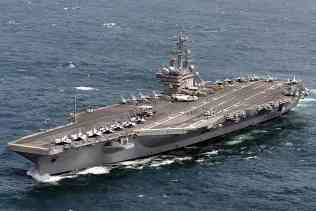
Taking off and landing is a great metaphor for the carrier. It’s designed to project power - and when needed, violence.
It’s hard to spend time on a carrier and not be impressed with the Navy, and the dedicated people who man the carrier and serve their country. And of course that’s the purpose of the two-day tour. The Navy calls its program Outreach: America’s Navy. Targeting key influencers (who they call Distinguished Visitors) the Navy hosts 900/year out to carriers off the West Coast and 500/year to carriers on the East Coast. These tours are scheduled when the carriers are offshore training, not when they are deployed on missions. I joined Pete Newell (my fellow instructor in the Hacking for Defense class) and 11 other Stanford faculty from CISAC and the Hoover Institution.
I learned quite a bit about the physical layout of a carrier, how the air crew operates and how the carrier functions in context of the other ships around it (the strike group.) But the biggest learning was the realization that disruption is not just happening to companies, it’s also happening to the Navy. And that the Lean Innovation tools we’ve built to deal with disruption and create continuous innovation for large commercial organizations were equally relevant here.
The Carrier
U.S. aircraft carriers like the Vinson (there are 9 others) are designed to put the equivalent of an Air Force base anywhere on any ocean anywhere in the world. This means the U.S. can show the flag for deterrence (don’t do this or it will be a bad day) or to control some part of the sea (to protect commercial and/or military shipping, or protect a Marine amphibious force - on the way or at a place they will land); and project power (a euphemism for striking targets with bombs and cruise missiles far from home).
On an aircraft carrier there are two groups of people - the crew needed to run the carrier, called the ship’s company, and the people who fly and support the aircraft they carry, called the Air Wing. The Vinson carries ~2,800 people in the ship’s company, ~2,000 in the Air Wing and ~150 staff.
Without the Air Wing the carrier would just be another big cruise ship. The Air Wing has 72 aircraft made up of jet and propeller planes. The core of the Air Wing are the 44 F/A-18 strike fighters.
http://www.youtube.com/watch?v=c0vKjewofLU
The F/A-18 strike fighters are designed to do two jobs: gain air superiority by engaging other fighter planes in the air or attack targets on the ground with bombs (that’s why they have the F/A designation). Flying on missions with these strike fighters are specially modified F/A-18’s - EA-18G Growlers that carry electronic warfare jammers which electronically shut down enemy radars and surface-to-air missiles to ensure that the F/A-18s get to the target without being shot down.
Another type of plane on the carrier is the propeller-driven E-2C Hawkeyes, which is an airborne early warning plane. Think of the Hawkeyes as airborne air traffic control. Hawkeyes carry a long-range radar in a dome above the fuselage, and keep the strike group and the fighters constantly aware of incoming air threats. They can send data to the fighters and to other ships in the battle group which identifies the location of potential threats. They can also detect other ships at sea.
The other planes in the carrier’s Air Wing are 16 helicopters: 8 MH-60S Nighthawk helicopters for logistics support, search and rescue and special warfare support; and 8 MH-60R Seahawks to locate and attack submarines and to attack Surface targets.

They carry sonobuoys, dipping sonar and anti-submarine torpedoes. And last but not least, there is the plane that got us on the carrier, the C2-A Greyhound - the delivery truck for the carrier.
You’re not alone
Carriers like the Vinson don’t go to sea by themselves. They’re part of a group of ships called the “carrier strike group.” A strike group consists of a carrier, two cruisers with Tomahawk cruise missiles which can attack land targets, and two destroyers and/or frigates with Aegis surface to air missiles to defend the carrier from air attack. (In the past, the strike group was assigned an attack submarine to hunt for subs trying to kill the carrier. Today the attack subs are in such demand they are assigned by national authorities on an as-needed basis.) The strike group also includes replenishment ships that carry spare ammunition, fuel, etc. (The 150 staff on the carrier include separate staff for the strike group, Air Wing, carrier, surface warfare (cruisers with tomahawk missiles) and air defense (Aegis-armed destroyers.)

The strike group also receives antisubmarine intelligence from P-3/P-8 anti-submarine aircraft and towed arrays on the destroyers, and additional situational awareness from imaging, Electronic Intelligence (ELINT) and radar sensors and satellites.
Before our group flew out to the carrier, we were briefed by Vice-Admiral Mike Shoemaker. His job is aviation Type Commander (TYCOM) for all United States Navy naval aviation units (responsible for aircrew training, supply, readiness, etc.) He also wears another hat as the commander of all the Navy planes in the Pacific. It was interesting to hear that the biggest issue in keeping the airplanes ready to fight are sequestration and budget cuts. These cuts have impacted maintenance, and made spare parts hard to get. And no pay raises make it hard to retain qualified people.
Then it was time to climb into our C-2 Greyhound for the flight out to the aircraft carrier. Just like a regular passenger plane, except you put on a life vest, goggles, ear plugs, and over all that a half helmet protecting the top and back of your head while enclosing your ears in large plastic ear muffs. Then you and 25 other passengers load the plane via the rear ramp, sit facing backwards in a plane with no windows and wait to land.
On the U.S.S. Vinson
Landing on an aircraft carrier is an equally violent act. When you make an arrested landing, a tail hook on the plane traps one of the four arresting cables stretched across the deck, and you decelerate from 105 mph to zero in two seconds. When the plane hit the arresting wire on the carrier deck, it came to a dead stop in 250 feet. There was absolutely no doubt that we had landed (and a great lesson on why you were wearing head protection, goggles and strapped into your non-reclining seat with a four-point harness). As the rear ramp lowered, we were assaulted with the visual and audio cacophony of crewmen in seven different colored shirts on the deck swarming on and around F-18s, E2Cs, helicopters, etc., all with their engines running.

Captain Doug Verissimo and his executive officer Captain Eric Anduze, welcomed us to the carrier. (One of my first problems onboard was translating Navy ranks into their Army/Air Force equivalents. For example, a navy captain equals an Air Force/Army Colonel, and a rear admiral is a brigadier general, etc.)

Then for the next two days the carrier’s public affairs officer led us on the “shock and awe” tour. In four years in the Air Force I had been stationed on four fighter bases, three of them in war zones, some with over 150 planes generating lots of sorties. But I had to grudgingly admit that watching F-18s landing on a 300-foot runway 60 feet above the water, on a pitching deck moving 30 mph at sea - one a minute - at night - was pretty impressive. And having us stand on the deck less than 50 feet away from these planes as they landed trapping the arrestor wires, and launched via a catapult was a testament to the Navy’s PR acumen. Most of crew on the flight deck are in their late teens and maybe early 20s. (And for me, hard to believe 4 decades ago in some other life I was doing that job.) Standing on the deck on a Navy carrier, it’s impossible not to be impressed with the precision choreography of the crew and the skill of their pilots.
http://www.youtube.com/watch?v=wj97iN-6KEA
Our group climbed the ladders (inclined at a 68-degree angle - there are no stairs) up and down the 18 decks (floors) of the ship. We saw the hangar deck where planes were repaired, the jet engine shop, jet engine test cell, arresting cable engine room, the bridge where they steer the ship, the flag bridge (the command center for the admiral), the flight deck control and launch operations room (where the aircraft handler keeps track of all the aircraft on the flight deck and in the hangar), and the carrier air traffic control center (CATCC).

At each stop an officer or enlisted man gave us an articulate description of what equipment we were looking at and how it fit into the rest of the carrier.
(What got left out of the tour was the combat direction center (CDC), the munitions elevators, ships engines and any of the avionics maintenance shops and of course, the nuclear reactor spaces.)
During lunch and dinners, we had a chance to talk at length to the officers and enlisted men. They were smart, dedicated and proud of what they do, and frank about the obstacles they face getting their jobs done. Interestingly they all echoed Vice-Admiral Shoemaker’s observation that the biggest obstacles they face are political - sequestration and budget cuts.
Just before we left we got a briefing from the head of the Carrier Strike Group, Rear Admiral James T. Loeblein about the threats the carrier and the strike group face.
Then it was off to be catapulted back home.

It’s clear that the public affairs office has a finely tuned PR machine. So if the goal was to impress me that the Navy and carriers are well run and manned - consider it done.
However, it got me thinking... new aircraft carrier’s cost $11 billion. And we have a lot of them on order. Given the threats they are facing are they going to be viable for another 30 years? Or is the aircraft carrier obsolete?
Tomorrow’s post will offer a few days’ worth of thoughts about carriers, strike groups and how the Navy can continue to innovate with carriers and beyond.
Lessons Learned - part 1 of 2
Our carriers are a work of art run and manned by professionals
Lots more in part 2, in the next post...
Thanks to the crew of the U.S.S. Vinson, and Commander Todd Cimicata and Stanford for a real education about the Navy.
http://www.huffingtonpost.com/steve-bla ... 41504.html
07/28/2016
Steve Blank Author, ‘The Startup Owner’s Manual’ and ‘The Four Steps to the Epiphany’
The future is here it’s just distributed unevenly - Silicon Valley view of tech adoption
The threat is here it’s just distributed unevenly - A2/AD and the aircraft carrier
Sitting backwards in a plane with no windows, strapped in a 4-point harness, wearing a life preserver, head encased in a helmet, eyes covered by googles, your brain can’t process the acceleration. As the C-2 A Greyhound is hurled off an aircraft carrier into the air via a catapult, your body thrown forward in the air, until a few seconds later, hundreds of feet above the carrier now at 150 miles per hour you yell, “Holy Shxt.” And no one can hear you through the noise, helmet and ear protectors.
—-
I just spent two days a hundred miles off the coast of Mexico aboard the U.S.S. Carl Vinson landing and taking off on the carrier deck via a small cargo plane.

Taking off and landing is a great metaphor for the carrier. It’s designed to project power - and when needed, violence.
It’s hard to spend time on a carrier and not be impressed with the Navy, and the dedicated people who man the carrier and serve their country. And of course that’s the purpose of the two-day tour. The Navy calls its program Outreach: America’s Navy. Targeting key influencers (who they call Distinguished Visitors) the Navy hosts 900/year out to carriers off the West Coast and 500/year to carriers on the East Coast. These tours are scheduled when the carriers are offshore training, not when they are deployed on missions. I joined Pete Newell (my fellow instructor in the Hacking for Defense class) and 11 other Stanford faculty from CISAC and the Hoover Institution.
I learned quite a bit about the physical layout of a carrier, how the air crew operates and how the carrier functions in context of the other ships around it (the strike group.) But the biggest learning was the realization that disruption is not just happening to companies, it’s also happening to the Navy. And that the Lean Innovation tools we’ve built to deal with disruption and create continuous innovation for large commercial organizations were equally relevant here.
The Carrier
U.S. aircraft carriers like the Vinson (there are 9 others) are designed to put the equivalent of an Air Force base anywhere on any ocean anywhere in the world. This means the U.S. can show the flag for deterrence (don’t do this or it will be a bad day) or to control some part of the sea (to protect commercial and/or military shipping, or protect a Marine amphibious force - on the way or at a place they will land); and project power (a euphemism for striking targets with bombs and cruise missiles far from home).
On an aircraft carrier there are two groups of people - the crew needed to run the carrier, called the ship’s company, and the people who fly and support the aircraft they carry, called the Air Wing. The Vinson carries ~2,800 people in the ship’s company, ~2,000 in the Air Wing and ~150 staff.
Without the Air Wing the carrier would just be another big cruise ship. The Air Wing has 72 aircraft made up of jet and propeller planes. The core of the Air Wing are the 44 F/A-18 strike fighters.
http://www.youtube.com/watch?v=c0vKjewofLU
The F/A-18 strike fighters are designed to do two jobs: gain air superiority by engaging other fighter planes in the air or attack targets on the ground with bombs (that’s why they have the F/A designation). Flying on missions with these strike fighters are specially modified F/A-18’s - EA-18G Growlers that carry electronic warfare jammers which electronically shut down enemy radars and surface-to-air missiles to ensure that the F/A-18s get to the target without being shot down.
Another type of plane on the carrier is the propeller-driven E-2C Hawkeyes, which is an airborne early warning plane. Think of the Hawkeyes as airborne air traffic control. Hawkeyes carry a long-range radar in a dome above the fuselage, and keep the strike group and the fighters constantly aware of incoming air threats. They can send data to the fighters and to other ships in the battle group which identifies the location of potential threats. They can also detect other ships at sea.
The other planes in the carrier’s Air Wing are 16 helicopters: 8 MH-60S Nighthawk helicopters for logistics support, search and rescue and special warfare support; and 8 MH-60R Seahawks to locate and attack submarines and to attack Surface targets.

They carry sonobuoys, dipping sonar and anti-submarine torpedoes. And last but not least, there is the plane that got us on the carrier, the C2-A Greyhound - the delivery truck for the carrier.
You’re not alone
Carriers like the Vinson don’t go to sea by themselves. They’re part of a group of ships called the “carrier strike group.” A strike group consists of a carrier, two cruisers with Tomahawk cruise missiles which can attack land targets, and two destroyers and/or frigates with Aegis surface to air missiles to defend the carrier from air attack. (In the past, the strike group was assigned an attack submarine to hunt for subs trying to kill the carrier. Today the attack subs are in such demand they are assigned by national authorities on an as-needed basis.) The strike group also includes replenishment ships that carry spare ammunition, fuel, etc. (The 150 staff on the carrier include separate staff for the strike group, Air Wing, carrier, surface warfare (cruisers with tomahawk missiles) and air defense (Aegis-armed destroyers.)

The strike group also receives antisubmarine intelligence from P-3/P-8 anti-submarine aircraft and towed arrays on the destroyers, and additional situational awareness from imaging, Electronic Intelligence (ELINT) and radar sensors and satellites.
Before our group flew out to the carrier, we were briefed by Vice-Admiral Mike Shoemaker. His job is aviation Type Commander (TYCOM) for all United States Navy naval aviation units (responsible for aircrew training, supply, readiness, etc.) He also wears another hat as the commander of all the Navy planes in the Pacific. It was interesting to hear that the biggest issue in keeping the airplanes ready to fight are sequestration and budget cuts. These cuts have impacted maintenance, and made spare parts hard to get. And no pay raises make it hard to retain qualified people.
Then it was time to climb into our C-2 Greyhound for the flight out to the aircraft carrier. Just like a regular passenger plane, except you put on a life vest, goggles, ear plugs, and over all that a half helmet protecting the top and back of your head while enclosing your ears in large plastic ear muffs. Then you and 25 other passengers load the plane via the rear ramp, sit facing backwards in a plane with no windows and wait to land.
On the U.S.S. Vinson
Landing on an aircraft carrier is an equally violent act. When you make an arrested landing, a tail hook on the plane traps one of the four arresting cables stretched across the deck, and you decelerate from 105 mph to zero in two seconds. When the plane hit the arresting wire on the carrier deck, it came to a dead stop in 250 feet. There was absolutely no doubt that we had landed (and a great lesson on why you were wearing head protection, goggles and strapped into your non-reclining seat with a four-point harness). As the rear ramp lowered, we were assaulted with the visual and audio cacophony of crewmen in seven different colored shirts on the deck swarming on and around F-18s, E2Cs, helicopters, etc., all with their engines running.

Captain Doug Verissimo and his executive officer Captain Eric Anduze, welcomed us to the carrier. (One of my first problems onboard was translating Navy ranks into their Army/Air Force equivalents. For example, a navy captain equals an Air Force/Army Colonel, and a rear admiral is a brigadier general, etc.)

Then for the next two days the carrier’s public affairs officer led us on the “shock and awe” tour. In four years in the Air Force I had been stationed on four fighter bases, three of them in war zones, some with over 150 planes generating lots of sorties. But I had to grudgingly admit that watching F-18s landing on a 300-foot runway 60 feet above the water, on a pitching deck moving 30 mph at sea - one a minute - at night - was pretty impressive. And having us stand on the deck less than 50 feet away from these planes as they landed trapping the arrestor wires, and launched via a catapult was a testament to the Navy’s PR acumen. Most of crew on the flight deck are in their late teens and maybe early 20s. (And for me, hard to believe 4 decades ago in some other life I was doing that job.) Standing on the deck on a Navy carrier, it’s impossible not to be impressed with the precision choreography of the crew and the skill of their pilots.
http://www.youtube.com/watch?v=wj97iN-6KEA
Our group climbed the ladders (inclined at a 68-degree angle - there are no stairs) up and down the 18 decks (floors) of the ship. We saw the hangar deck where planes were repaired, the jet engine shop, jet engine test cell, arresting cable engine room, the bridge where they steer the ship, the flag bridge (the command center for the admiral), the flight deck control and launch operations room (where the aircraft handler keeps track of all the aircraft on the flight deck and in the hangar), and the carrier air traffic control center (CATCC).

At each stop an officer or enlisted man gave us an articulate description of what equipment we were looking at and how it fit into the rest of the carrier.
(What got left out of the tour was the combat direction center (CDC), the munitions elevators, ships engines and any of the avionics maintenance shops and of course, the nuclear reactor spaces.)
During lunch and dinners, we had a chance to talk at length to the officers and enlisted men. They were smart, dedicated and proud of what they do, and frank about the obstacles they face getting their jobs done. Interestingly they all echoed Vice-Admiral Shoemaker’s observation that the biggest obstacles they face are political - sequestration and budget cuts.
Just before we left we got a briefing from the head of the Carrier Strike Group, Rear Admiral James T. Loeblein about the threats the carrier and the strike group face.
Then it was off to be catapulted back home.

It’s clear that the public affairs office has a finely tuned PR machine. So if the goal was to impress me that the Navy and carriers are well run and manned - consider it done.
However, it got me thinking... new aircraft carrier’s cost $11 billion. And we have a lot of them on order. Given the threats they are facing are they going to be viable for another 30 years? Or is the aircraft carrier obsolete?
Tomorrow’s post will offer a few days’ worth of thoughts about carriers, strike groups and how the Navy can continue to innovate with carriers and beyond.
Lessons Learned - part 1 of 2
Our carriers are a work of art run and manned by professionals
Lots more in part 2, in the next post...
Thanks to the crew of the U.S.S. Vinson, and Commander Todd Cimicata and Stanford for a real education about the Navy.
http://www.huffingtonpost.com/steve-bla ... 41504.html
- akivrx78
- Sênior

- Mensagens: 6354
- Registrado em: Dom Fev 08, 2009 8:16 am
- Agradeceu: 104 vezes
- Agradeceram: 326 vezes
Re: Marinha dos EUA
Why The Navy Needs Disruption Now (Part 2 Of 2)
07/29/2016 11:25 am ET | Updated 21 hours ago
Steve Blank Author, ‘The Startup Owner’s Manual’ and ‘The Four Steps to the Epiphany’
The future is here it’s just distributed unevenly - Silicon Valley view of tech adoption
The threat is here it’s just distributed unevenly - A2/AD and the aircraft carrier
This is the second of a two-part post following my stay on the aircraft carrier USS Carl Vinson. Part 1 talked about what I saw and learned - the layout of a carrier, how the air crew operates and how the carrier functions in context of the other ships around it (the strike group.) But the biggest learning was the realization that disruption is not just happening to companies, it’s also happening to the Navy. And that the Lean Innovation tools we’ve built to deal with disruption and create continuous innovation for large commercial organizations were equally relevant here.
This post offers a few days’ worth of thinking about what I saw. (If you haven’t, read part 1 first.)
—-
The threat is here; it’s just distributed unevenly - A2/AD and the aircraft carrier
Both of the following statements are true:
The aircraft carrier is viable for another 30 years.
The aircraft carrier is obsolete.
Well-defended targets
Think of an aircraft carrier as a $11 billion dollar portable air force base manned by 5,000 people delivering 44 F/A-18 strike fighters anywhere in the world.
The primary roles of the 44 F/A-18 strike fighters that form the core of the carrier’s air wing is to control the air and drop bombs on enemy targets. For targets over uncontested airspace (Iraq, Afghanistan, Syria, Somalia, Yemen, Libya, etc.) that’s pretty easy. The problem is that First World countries have developed formidable surface-to-air missiles - the Russian S-300 and S-400 and the Chinese HQ-9 - which have become extremely effective at shooting down aircraft. And they have been selling these systems to other countries (Iran, Syria, Egypt, etc.). While the role of an aircraft carrier’s EA-18G Growlers is to jam/confuse the radar of these missiles, the sophistication and range of these surface-to-air missiles have been evolving faster than the jamming countermeasures on the EA-18G Growlers (and the cyber hacks to shut the radars down).
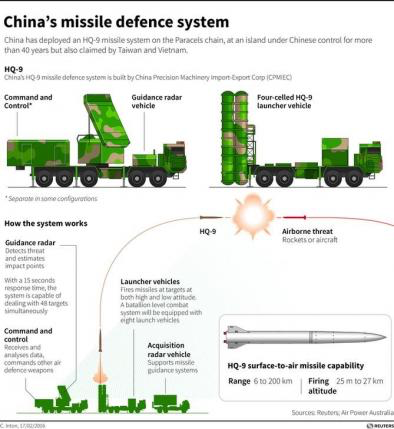
This means that the odds of a carrier-based F/A-18 strike fighter successfully reaching a target defended by these modern surface-to-air missiles is diminishing yearly. Unless the U.S. military can take these air defense systems out with drones, cruise missiles or cyber attack, brave and skilled pilots may not be enough. Given the F/A-18’s are manned aircraft (versus drones), high losses of pilots may be (politically) unacceptable.
Vulnerable carriers
If you want to kill a carrier, first you must find it and then you have to track it. In WWII knowing where the enemy fleet located was a big - and critical - question. Today, photo imaging satellites, satellites that track electronic emissions (radio, radar, etc.) and satellites with synthetic aperture radar that can see through clouds and at night are able to pinpoint the strike group and carrier 24/7. In the 20th century only the Soviet Union had this capability. Today, China can do this in the Pacific and to a limited extent, Iran has this capability in the Persian Gulf. Soon there will be enough commercial satellite coverage of the Earth using the same sensors, that virtually anyone able to pay for the data will be able to track the ships.
During the Cold War the primary threat to carriers was from the air - from strike/fighters dropping bombs/torpedoes or from cruise missiles (launched from ships and planes). While the Soviets had attack submarines, our anti-Submarine Warfare (ASW) capabilities (along with very noisy Soviet subs pre-Walker spy ring) made subs a secondary threat to carriers.
In the 20th century the war plan for a carrier strike group used its fighter and attack aircraft and Tomahawk cruise missiles launched from the cruisers to destroy enemy radar, surface-to-air missiles, aircraft and communications (including satellite downlinks). As those threats are eliminated, the carrier strike can move closer to land without fear of attack. This allowed the attack aircraft to loiter longer over targets or extend their reach over enemy territory.
Carriers were designed to be most effective launching a high number of sorties (number of flights) from ~225 miles from the target. For example, we can cruise offshore of potential adversaries (Iraq and Syria) who can’t get to our carriers. (Carriers can standoff farther or can reach further inland, but they have to launch F-18’s as refueling tankers to extend the mission range. For example, missions into Afghanistan are 6-8 hours versus normal mission times of 2-3 hours.)
In the 21st century carrier strike groups are confronting better equipped adversaries, and today carriers face multiple threats before they can launch an initial strike. These threats include much quieter submarines, long-range, sea-skimming cruise missiles, and in the Pacific, a potential disruptive game changer - ballistic missiles armed with non-nuclear maneuverable warheads that can hit a carrier deck as it maneuvers at speed (DF-21d and the longer range DF-26).
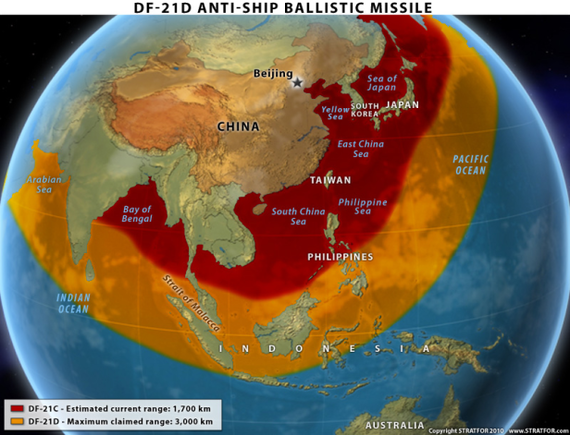
In the Persian Gulf the carriers face another threat - Fast Inshore Attack Craft (FIAC) and speedboats with anti-ship cruise missiles that can be launched from shore.
The sum of all these threats - to the carrier-based aircraft and the carriers themselves - are called anti-access/area denial (A2/AD) capabilities.
Eventually the cost and probability of defending the carrier as a manned aircraft platform becomes untenable in highly defended A2/AD environments like the western Pacific or the Persian Gulf. (This seems to be exactly the problem the manned bomber folks are facing in multiple regions.) But if not a carrier, what will they use to project power? While the carrier might become obsolete, the mission certainly has not.
So how does/should the Navy solve these problems?
Three Horizons of Innovation
One useful way to think about in innovation in the face of increasing disruption / competition is called the “Three Horizons of Innovation.” It suggests that an organization should think about innovation across three categories called “Horizons.”
Horizon 1 activities support executing the existing mission with ever increasing efficiency
Horizon 2 is focused on extending the core mission
Horizon 3 is focused on searching for and creating brand new missions (see here for background on the Three Horizons.)
Horizon 1 is the Navy’s core mission. Here the Navy executes against a set of known mission requirements (known beneficiaries, known ships and planes, known adversaries, deployment, supply chain, etc.) It uses existing capabilities and has comparatively low risk to get the next improvement out the door.
In a well-run organization like the Navy, innovation and improvement occurs continuously in Horizon 1. Branches of the Navy innovate on new equipment, new tactics, new procurement processes, more sorties on newer carriers, etc. As fighter pilots want more capable manned aircraft and carrier captains want better carriers, it’s not a surprise that Horizon 1 innovations are upgrades - the next generation of carriers - Ford Class; and next generation of navy aircraft - the F-35C. As a failure here can impact the Navy’s current mission, Horizon 1 uses traditional product management tools to minimize risk and assure execution. (And yes, like any complex project they still manage to be over budget and miss their delivery schedule.)
http://www.youtube.com/watch?v=APuYyfq12ts
Because failure here is unacceptable, Navy Horizon 1 programs and people are managed by building repeatable and scalable processes, procedures, incentives and promotions to execute and the mission.
In Horizon 2, the Navy extends its core mission. Here it looks for new opportunities within its existing mission (trying new technology on the same platform, using the same technology with new missions, etc.) Horizon 2 uses mostly existing capabilities (the carrier as an aircraft platform, aircraft to deliver munitions) and has moderate risk in building or securing new capabilities to get the product out the door.
An example of potential Naval Horizon 2 innovations is unmanned drones flying off carriers to do the jobs fighter pilots hate such as serving as airborne tankers (who wants to fly a gas tank around for 6 hours?) and ISR (Intelligence, Surveillance and Reconnaissance), another tedious mission flying around for hours that could be better solved with a drone downlinking ISR data for processing on board a ship.
However, getting the tanker and ISR functions onto drones only delays the inevitable shift to drones for strike, and then for fighters. The problem of strike fighters’ increasing difficulty in penetrating heavily defended targets isn’t going to get better with the new F-35C (the replacement for the F/A-18). In fact, it will get worse. Regardless of the bravery and skill of the pilots, they will face air defense systems evolving at a faster rate than the defensive systems on the aircraft. It’s not at all clear in a low-intensity conflict (think Bosnia or Syria) that civilian leadership will want to risk captured or killed pilots and losing planes like the F-35C that cost several hundred million dollars each.
http://www.youtube.com/watch?v=kw3m7bqrQ64
Management in Horizon 2 works by pattern recognition and experimentation inside the current mission model. Ironically, institutional inertia keeps the Navy from deploying unmanned assets on carriers. In a perfect world, drones in carrier tanker and ISR roles should have been deployed by the beginning of this decade. And by now experience with them on a carrier deck could have led to first, autonomous wingmen and eventually autonomous missions. Instead the system appears to have fallen into the “real men fly planes and command Air Wings and get promoted by others who do” mindset.
The Navy does not lack drone demos and prototypes, but it has failed to deploy Horizon 2 innovations with speed and urgency. Failure to act aggressively here will impact the Navy’s ability to carry out its mission of sea control and power projection. (The Hudson Institute report on the future of the carrier is worth a read, and a RAND report on the same topic comes out in October.)
If you think Horizon 2 innovation is hard in the Navy, wait until you get to Horizon 3. This is where disruption happens. It’s how the aircraft carrier disrupted the battleship. How nuclear-powered ballistic missile submarines changed the nature of strategic deterrence, and how the DF-21/26 and artificial islands in the South China sea changed decades of assumptions. And it’s why, in most organizations, innovation dies.
For the Navy, a Horizon 3 conversation would not be about better carriers and aircraft. Instead it would focus on the core reasons the Navy deploys a carrier strike group: to show the flag for deterrence, or to control part of the sea to protect shipping, or to protect a Marine amphibious force, or to project offensive power against any adversary in well-defended areas.
A Horizon 3 solution for the Navy would start with basic need of these missions (sea control, offensive power projection - sortie generation) the logistic requirements that come with them, and the barriers to their success like A2/AD threats. Lots of people have been talking and writing about this and lots of Horizon 3 concepts have been proposed such as Distributed Lethality, Arsenal Ships, underwater drone platforms, etc.
http://www.youtube.com/watch?v=21dFaIIeXpU
Focusing on these goals - not building or commanding carriers, or building and flying planes - is really, really hard. It’s hard to get existing operational organizations to think about disruption because it means they have to be thinking about obsoleting a job, function or skill they’ve spent their lives perfecting. It’s hard because any large organization is led by people who succeeded as Horizon 1 and 2 managers and operators (not researchers). Their whole focus, career, incentives, etc. has been about building and make the current platforms work. And the Navy has excelled in doing so.
The problem is that Horizon 3 solutions take different people, different portfolio, different process and different politics.
People: In Horizon 1 and 2 programs people who fail don’t get promoted because in a known process failure to execute is a failure of individual performance. However, applying the same rules to Horizon 3 programs - no failures tolerated - means we’ll have no learning and no disruptive innovations. What spooks leadership is that in Horizon 3 most of the projects will fail. But using Lean Innovation they’ll fail quickly and cheaply.
In Horizon 3 the initial program is run by mavericks - the crazy innovators. In the Navy, these are the people you want to court martial or pass over for promotion for not getting with current program. (In a startup they’d be the founding CEO.) These are the fearless innovators you want to create new and potentially disruptive mission models. Failure to support their potential disruptive talent means it will go elsewhere.
Portfolio: In Horizon 3, the Navy is essentially incubating a startup. And not just one. The Navy needs a portfolio of Horizon 3 bets, for the same reason venture capital and large companies have a portfolio of Horizon 3 bets - most of these bets will fail - but the ones that succeed are game changers.
Process: A critical difference between a Horizon 3 bet and a Horizon 1 or 2 bet is that you don’t build large, expensive, multi-year programs to test radically new concepts (think of the Zumwalt class destroyers). You use “Lean” techniques to build Minimal Viable Products (MVPs). MVPs are whatever it takes to get you the most learning in the shortest period of time.
Horizon 3 groups operate with speed and urgency - the goal is rapid learning. They need to be physically separate from operating divisions in an incubator, or their own facility. And they need their own plans, procedures, policies, incentives and Key Performance Indicators (KPIs) different from those in Horizon 1.
The watchwords in Horizon 3 are “If everything seems under control, you’re just not going fast enough.”
Politics: In Silicon Valley most startups fail. That’s why we invest in a portfolio of new ideas, not just one. We embrace failure as an integral part of learning. We do so by realizing that in Horizon 3 we are testing hypotheses - a series of unknowns - not executing knowns. Yet failure/learning is a dirty word in the world of promotions and the “gotcha game” of politics. To survive in this environment Horizon 3 leaders must learn how to communicate up/down and sideways that they are not running Horizon 1 and 2 projects.
Meanwhile, Navy and DOD leadership has to invest in, and clearly communicate their innovation strategy across all three Horizons.
Failure to manage innovation across all three Horizons and failure to make a portfolio of Horizon 3 bets means that the Navy is exposed to disruption by new entrants. Entrants unencumbered by decades of success, fueled by their own version of manifest destiny.
Lessons Learned
— Our carriers are a work of art run and manned by professionals
Threats that can degrade or negate a carrier strike group exist in multiple areas
However, carriers are still a significant asset in almost all other combat scenarios
— Speed and urgency rather than institutional inertia should be the watchwords for Horizon 2 innovation
— Horizon 3 innovation is about a clean sheet of paper thinking
It’s what Silicon Valley calls disruption
It requires different people, portfolio, process and politics
— The Navy (and DOD) must manage innovation across all three Horizons
Allocating dollars and resources for each
— Remembering that todays Horizon 3 crazy idea is tomorrow Horizon 1 platform
Thanks to the crew of the U.S.S. Vinson, and Commander Todd Cimicata and Stanford for a real education about the Navy.
Steve Blank’s blog: http://www.steveblank.com
http://www.huffingtonpost.com/steve-bla ... 59302.html
07/29/2016 11:25 am ET | Updated 21 hours ago
Steve Blank Author, ‘The Startup Owner’s Manual’ and ‘The Four Steps to the Epiphany’
The future is here it’s just distributed unevenly - Silicon Valley view of tech adoption
The threat is here it’s just distributed unevenly - A2/AD and the aircraft carrier
This is the second of a two-part post following my stay on the aircraft carrier USS Carl Vinson. Part 1 talked about what I saw and learned - the layout of a carrier, how the air crew operates and how the carrier functions in context of the other ships around it (the strike group.) But the biggest learning was the realization that disruption is not just happening to companies, it’s also happening to the Navy. And that the Lean Innovation tools we’ve built to deal with disruption and create continuous innovation for large commercial organizations were equally relevant here.
This post offers a few days’ worth of thinking about what I saw. (If you haven’t, read part 1 first.)
—-
The threat is here; it’s just distributed unevenly - A2/AD and the aircraft carrier
Both of the following statements are true:
The aircraft carrier is viable for another 30 years.
The aircraft carrier is obsolete.
Well-defended targets
Think of an aircraft carrier as a $11 billion dollar portable air force base manned by 5,000 people delivering 44 F/A-18 strike fighters anywhere in the world.
The primary roles of the 44 F/A-18 strike fighters that form the core of the carrier’s air wing is to control the air and drop bombs on enemy targets. For targets over uncontested airspace (Iraq, Afghanistan, Syria, Somalia, Yemen, Libya, etc.) that’s pretty easy. The problem is that First World countries have developed formidable surface-to-air missiles - the Russian S-300 and S-400 and the Chinese HQ-9 - which have become extremely effective at shooting down aircraft. And they have been selling these systems to other countries (Iran, Syria, Egypt, etc.). While the role of an aircraft carrier’s EA-18G Growlers is to jam/confuse the radar of these missiles, the sophistication and range of these surface-to-air missiles have been evolving faster than the jamming countermeasures on the EA-18G Growlers (and the cyber hacks to shut the radars down).

This means that the odds of a carrier-based F/A-18 strike fighter successfully reaching a target defended by these modern surface-to-air missiles is diminishing yearly. Unless the U.S. military can take these air defense systems out with drones, cruise missiles or cyber attack, brave and skilled pilots may not be enough. Given the F/A-18’s are manned aircraft (versus drones), high losses of pilots may be (politically) unacceptable.
Vulnerable carriers
If you want to kill a carrier, first you must find it and then you have to track it. In WWII knowing where the enemy fleet located was a big - and critical - question. Today, photo imaging satellites, satellites that track electronic emissions (radio, radar, etc.) and satellites with synthetic aperture radar that can see through clouds and at night are able to pinpoint the strike group and carrier 24/7. In the 20th century only the Soviet Union had this capability. Today, China can do this in the Pacific and to a limited extent, Iran has this capability in the Persian Gulf. Soon there will be enough commercial satellite coverage of the Earth using the same sensors, that virtually anyone able to pay for the data will be able to track the ships.
During the Cold War the primary threat to carriers was from the air - from strike/fighters dropping bombs/torpedoes or from cruise missiles (launched from ships and planes). While the Soviets had attack submarines, our anti-Submarine Warfare (ASW) capabilities (along with very noisy Soviet subs pre-Walker spy ring) made subs a secondary threat to carriers.
In the 20th century the war plan for a carrier strike group used its fighter and attack aircraft and Tomahawk cruise missiles launched from the cruisers to destroy enemy radar, surface-to-air missiles, aircraft and communications (including satellite downlinks). As those threats are eliminated, the carrier strike can move closer to land without fear of attack. This allowed the attack aircraft to loiter longer over targets or extend their reach over enemy territory.
Carriers were designed to be most effective launching a high number of sorties (number of flights) from ~225 miles from the target. For example, we can cruise offshore of potential adversaries (Iraq and Syria) who can’t get to our carriers. (Carriers can standoff farther or can reach further inland, but they have to launch F-18’s as refueling tankers to extend the mission range. For example, missions into Afghanistan are 6-8 hours versus normal mission times of 2-3 hours.)
In the 21st century carrier strike groups are confronting better equipped adversaries, and today carriers face multiple threats before they can launch an initial strike. These threats include much quieter submarines, long-range, sea-skimming cruise missiles, and in the Pacific, a potential disruptive game changer - ballistic missiles armed with non-nuclear maneuverable warheads that can hit a carrier deck as it maneuvers at speed (DF-21d and the longer range DF-26).

In the Persian Gulf the carriers face another threat - Fast Inshore Attack Craft (FIAC) and speedboats with anti-ship cruise missiles that can be launched from shore.
The sum of all these threats - to the carrier-based aircraft and the carriers themselves - are called anti-access/area denial (A2/AD) capabilities.
Eventually the cost and probability of defending the carrier as a manned aircraft platform becomes untenable in highly defended A2/AD environments like the western Pacific or the Persian Gulf. (This seems to be exactly the problem the manned bomber folks are facing in multiple regions.) But if not a carrier, what will they use to project power? While the carrier might become obsolete, the mission certainly has not.
So how does/should the Navy solve these problems?
Three Horizons of Innovation
One useful way to think about in innovation in the face of increasing disruption / competition is called the “Three Horizons of Innovation.” It suggests that an organization should think about innovation across three categories called “Horizons.”
Horizon 1 activities support executing the existing mission with ever increasing efficiency
Horizon 2 is focused on extending the core mission
Horizon 3 is focused on searching for and creating brand new missions (see here for background on the Three Horizons.)
Horizon 1 is the Navy’s core mission. Here the Navy executes against a set of known mission requirements (known beneficiaries, known ships and planes, known adversaries, deployment, supply chain, etc.) It uses existing capabilities and has comparatively low risk to get the next improvement out the door.
In a well-run organization like the Navy, innovation and improvement occurs continuously in Horizon 1. Branches of the Navy innovate on new equipment, new tactics, new procurement processes, more sorties on newer carriers, etc. As fighter pilots want more capable manned aircraft and carrier captains want better carriers, it’s not a surprise that Horizon 1 innovations are upgrades - the next generation of carriers - Ford Class; and next generation of navy aircraft - the F-35C. As a failure here can impact the Navy’s current mission, Horizon 1 uses traditional product management tools to minimize risk and assure execution. (And yes, like any complex project they still manage to be over budget and miss their delivery schedule.)
http://www.youtube.com/watch?v=APuYyfq12ts
Because failure here is unacceptable, Navy Horizon 1 programs and people are managed by building repeatable and scalable processes, procedures, incentives and promotions to execute and the mission.
In Horizon 2, the Navy extends its core mission. Here it looks for new opportunities within its existing mission (trying new technology on the same platform, using the same technology with new missions, etc.) Horizon 2 uses mostly existing capabilities (the carrier as an aircraft platform, aircraft to deliver munitions) and has moderate risk in building or securing new capabilities to get the product out the door.
An example of potential Naval Horizon 2 innovations is unmanned drones flying off carriers to do the jobs fighter pilots hate such as serving as airborne tankers (who wants to fly a gas tank around for 6 hours?) and ISR (Intelligence, Surveillance and Reconnaissance), another tedious mission flying around for hours that could be better solved with a drone downlinking ISR data for processing on board a ship.
However, getting the tanker and ISR functions onto drones only delays the inevitable shift to drones for strike, and then for fighters. The problem of strike fighters’ increasing difficulty in penetrating heavily defended targets isn’t going to get better with the new F-35C (the replacement for the F/A-18). In fact, it will get worse. Regardless of the bravery and skill of the pilots, they will face air defense systems evolving at a faster rate than the defensive systems on the aircraft. It’s not at all clear in a low-intensity conflict (think Bosnia or Syria) that civilian leadership will want to risk captured or killed pilots and losing planes like the F-35C that cost several hundred million dollars each.
http://www.youtube.com/watch?v=kw3m7bqrQ64
Management in Horizon 2 works by pattern recognition and experimentation inside the current mission model. Ironically, institutional inertia keeps the Navy from deploying unmanned assets on carriers. In a perfect world, drones in carrier tanker and ISR roles should have been deployed by the beginning of this decade. And by now experience with them on a carrier deck could have led to first, autonomous wingmen and eventually autonomous missions. Instead the system appears to have fallen into the “real men fly planes and command Air Wings and get promoted by others who do” mindset.
The Navy does not lack drone demos and prototypes, but it has failed to deploy Horizon 2 innovations with speed and urgency. Failure to act aggressively here will impact the Navy’s ability to carry out its mission of sea control and power projection. (The Hudson Institute report on the future of the carrier is worth a read, and a RAND report on the same topic comes out in October.)
If you think Horizon 2 innovation is hard in the Navy, wait until you get to Horizon 3. This is where disruption happens. It’s how the aircraft carrier disrupted the battleship. How nuclear-powered ballistic missile submarines changed the nature of strategic deterrence, and how the DF-21/26 and artificial islands in the South China sea changed decades of assumptions. And it’s why, in most organizations, innovation dies.
For the Navy, a Horizon 3 conversation would not be about better carriers and aircraft. Instead it would focus on the core reasons the Navy deploys a carrier strike group: to show the flag for deterrence, or to control part of the sea to protect shipping, or to protect a Marine amphibious force, or to project offensive power against any adversary in well-defended areas.
A Horizon 3 solution for the Navy would start with basic need of these missions (sea control, offensive power projection - sortie generation) the logistic requirements that come with them, and the barriers to their success like A2/AD threats. Lots of people have been talking and writing about this and lots of Horizon 3 concepts have been proposed such as Distributed Lethality, Arsenal Ships, underwater drone platforms, etc.
http://www.youtube.com/watch?v=21dFaIIeXpU
Focusing on these goals - not building or commanding carriers, or building and flying planes - is really, really hard. It’s hard to get existing operational organizations to think about disruption because it means they have to be thinking about obsoleting a job, function or skill they’ve spent their lives perfecting. It’s hard because any large organization is led by people who succeeded as Horizon 1 and 2 managers and operators (not researchers). Their whole focus, career, incentives, etc. has been about building and make the current platforms work. And the Navy has excelled in doing so.
The problem is that Horizon 3 solutions take different people, different portfolio, different process and different politics.
People: In Horizon 1 and 2 programs people who fail don’t get promoted because in a known process failure to execute is a failure of individual performance. However, applying the same rules to Horizon 3 programs - no failures tolerated - means we’ll have no learning and no disruptive innovations. What spooks leadership is that in Horizon 3 most of the projects will fail. But using Lean Innovation they’ll fail quickly and cheaply.
In Horizon 3 the initial program is run by mavericks - the crazy innovators. In the Navy, these are the people you want to court martial or pass over for promotion for not getting with current program. (In a startup they’d be the founding CEO.) These are the fearless innovators you want to create new and potentially disruptive mission models. Failure to support their potential disruptive talent means it will go elsewhere.
Portfolio: In Horizon 3, the Navy is essentially incubating a startup. And not just one. The Navy needs a portfolio of Horizon 3 bets, for the same reason venture capital and large companies have a portfolio of Horizon 3 bets - most of these bets will fail - but the ones that succeed are game changers.
Process: A critical difference between a Horizon 3 bet and a Horizon 1 or 2 bet is that you don’t build large, expensive, multi-year programs to test radically new concepts (think of the Zumwalt class destroyers). You use “Lean” techniques to build Minimal Viable Products (MVPs). MVPs are whatever it takes to get you the most learning in the shortest period of time.
Horizon 3 groups operate with speed and urgency - the goal is rapid learning. They need to be physically separate from operating divisions in an incubator, or their own facility. And they need their own plans, procedures, policies, incentives and Key Performance Indicators (KPIs) different from those in Horizon 1.
The watchwords in Horizon 3 are “If everything seems under control, you’re just not going fast enough.”
Politics: In Silicon Valley most startups fail. That’s why we invest in a portfolio of new ideas, not just one. We embrace failure as an integral part of learning. We do so by realizing that in Horizon 3 we are testing hypotheses - a series of unknowns - not executing knowns. Yet failure/learning is a dirty word in the world of promotions and the “gotcha game” of politics. To survive in this environment Horizon 3 leaders must learn how to communicate up/down and sideways that they are not running Horizon 1 and 2 projects.
Meanwhile, Navy and DOD leadership has to invest in, and clearly communicate their innovation strategy across all three Horizons.
Failure to manage innovation across all three Horizons and failure to make a portfolio of Horizon 3 bets means that the Navy is exposed to disruption by new entrants. Entrants unencumbered by decades of success, fueled by their own version of manifest destiny.
Lessons Learned
— Our carriers are a work of art run and manned by professionals
Threats that can degrade or negate a carrier strike group exist in multiple areas
However, carriers are still a significant asset in almost all other combat scenarios
— Speed and urgency rather than institutional inertia should be the watchwords for Horizon 2 innovation
— Horizon 3 innovation is about a clean sheet of paper thinking
It’s what Silicon Valley calls disruption
It requires different people, portfolio, process and politics
— The Navy (and DOD) must manage innovation across all three Horizons
Allocating dollars and resources for each
— Remembering that todays Horizon 3 crazy idea is tomorrow Horizon 1 platform
Thanks to the crew of the U.S.S. Vinson, and Commander Todd Cimicata and Stanford for a real education about the Navy.
Steve Blank’s blog: http://www.steveblank.com
http://www.huffingtonpost.com/steve-bla ... 59302.html
- akivrx78
- Sênior

- Mensagens: 6354
- Registrado em: Dom Fev 08, 2009 8:16 am
- Agradeceu: 104 vezes
- Agradeceram: 326 vezes
Re: Marinha dos EUA
The U.S. Navy Is Unleashing The World's Biggest Underwater Battle Robot
The Sea Hunter will go on missions for up to three months at a time--with no humans on board.
Maxim Staff
7 hours ago
http://www.youtube.com/watch?v=IsDivRmGIVI
The U.S. Navy Is Unleashing The World's Biggest Underwater Battle Robot
We can now add underwater warfare to the growing list of things robots will do for us in the future.
In San Diego this week, the Sea Hunter, a massive, 132-foot autonomous submarine, passed its first performance test. It now looks like it will make the cut off to enter the Navy’s fleet by 2018, Vocativ reports.
“[The Sea Hunter] surpassed all performance objectives for speed, maneuverability, stability, seakeeping, acceleration/deceleration, and fuel consumption,” Leidos, the company behind the vessel, said in a statement.
Though the tests have been manned so far, the upcoming ones will see the vessel cruising without human assistance. When it’s off to sea, it will be able to remain there for three full months with little to no remote control operation.
Not only will it be able to detect diesel-electric submarines (cough, China, cough) it is also being envisioned for a variety of uses.
“What we’ve kind of realized over the course of the program is that it’s a truck,” Scott Littlefield, a program manager for the U.S. Defense Advanced Research Projects Agency, told IEEE Spectrum. “It’s got lots of payload capacity for a variety of different missions.”
The added bonus of the Sea Hunter? It brings the cost of operations down to $20,000 a day — compared to $700,000 for a manned Navy warship.
The robots win again.
http://www.maxim.com/news/sea-hunter-na ... ne-2016-08
The Sea Hunter will go on missions for up to three months at a time--with no humans on board.
Maxim Staff
7 hours ago
http://www.youtube.com/watch?v=IsDivRmGIVI
The U.S. Navy Is Unleashing The World's Biggest Underwater Battle Robot
We can now add underwater warfare to the growing list of things robots will do for us in the future.
In San Diego this week, the Sea Hunter, a massive, 132-foot autonomous submarine, passed its first performance test. It now looks like it will make the cut off to enter the Navy’s fleet by 2018, Vocativ reports.
“[The Sea Hunter] surpassed all performance objectives for speed, maneuverability, stability, seakeeping, acceleration/deceleration, and fuel consumption,” Leidos, the company behind the vessel, said in a statement.
Though the tests have been manned so far, the upcoming ones will see the vessel cruising without human assistance. When it’s off to sea, it will be able to remain there for three full months with little to no remote control operation.
Not only will it be able to detect diesel-electric submarines (cough, China, cough) it is also being envisioned for a variety of uses.
“What we’ve kind of realized over the course of the program is that it’s a truck,” Scott Littlefield, a program manager for the U.S. Defense Advanced Research Projects Agency, told IEEE Spectrum. “It’s got lots of payload capacity for a variety of different missions.”
The added bonus of the Sea Hunter? It brings the cost of operations down to $20,000 a day — compared to $700,000 for a manned Navy warship.
The robots win again.
http://www.maxim.com/news/sea-hunter-na ... ne-2016-08
- akivrx78
- Sênior

- Mensagens: 6354
- Registrado em: Dom Fev 08, 2009 8:16 am
- Agradeceu: 104 vezes
- Agradeceram: 326 vezes
Re: Marinha dos EUA
Raytheon Standard Missile-3 production ramps up after $523M order
Travis Leder Updated 40 min ago 0

The U.S. Missile Defense Agency (MDA) is ordering 47 Standard Missile-3 (SM-3) Block IB interceptors after exercising a lucrative contract option.
Raytheon says it will produce the interceptors at its Space Factory in Tuscon, Arizona, while integration is expected to take place at the company's Redstone Arsenal facility.
The defense company says it has delivered more than 270 SM-3s, which are used to destroy ballistic missile threats on impact alone. The U.S. Navy uses the interceptors to bolster regional defense.
http://www.youtube.com/watch?v=xfESTfeQluA
The 55,000-square-foot Raytheon Redstone Missile Integration Facility was built to help produce the SM-3 and SM-6 interceptors. It features automatic guided vehicles which transfer components using lasers. The battery-powered vehicles use safety systems which allow them to stop smoothly if anyone approaches.
The SM-3 is considered a key asset to missile defense in the European theater as part of President Barack Obama's Phased Adaptive Approach.
http://www.waaytv.com/tech_alabama/rayt ... a3ffd.html
Travis Leder Updated 40 min ago 0

The U.S. Missile Defense Agency (MDA) is ordering 47 Standard Missile-3 (SM-3) Block IB interceptors after exercising a lucrative contract option.
Raytheon says it will produce the interceptors at its Space Factory in Tuscon, Arizona, while integration is expected to take place at the company's Redstone Arsenal facility.
The defense company says it has delivered more than 270 SM-3s, which are used to destroy ballistic missile threats on impact alone. The U.S. Navy uses the interceptors to bolster regional defense.
http://www.youtube.com/watch?v=xfESTfeQluA
The 55,000-square-foot Raytheon Redstone Missile Integration Facility was built to help produce the SM-3 and SM-6 interceptors. It features automatic guided vehicles which transfer components using lasers. The battery-powered vehicles use safety systems which allow them to stop smoothly if anyone approaches.
The SM-3 is considered a key asset to missile defense in the European theater as part of President Barack Obama's Phased Adaptive Approach.
http://www.waaytv.com/tech_alabama/rayt ... a3ffd.html
- akivrx78
- Sênior

- Mensagens: 6354
- Registrado em: Dom Fev 08, 2009 8:16 am
- Agradeceu: 104 vezes
- Agradeceram: 326 vezes
Re: Marinha dos EUA
Raytheon awarded a $287.9 Million contract to upgrade Close-In Weapon System (CIWS)
Friday, 05 August 2016
Raytheon Company has been awarded a $287.9 million contract modification for MK 15 Close-In Weapon System (CIWS) upgrades and conversions, system overhauls, and associated hardware. This contract combines purchases for the US Navy (36.75 percent) and for the governments of Turkey (44.09 percent) and Australia (19.16 percent), under the Foreign Military Sales (FMS) program.
Raytheon Company has been awarded a $287.9 million contract modification for MK 15 Close-In Weapon System (CIWS) upgrades and conversions, system overhauls, and associated hardware. This contract combines purchases for the US Navy (36.75 percent) and for the governments of Turkey (44.09 percent) and Australia (19.16 percent), under the Foreign Military Sales (FMS) program.
Phalanx Close-In Weapon System
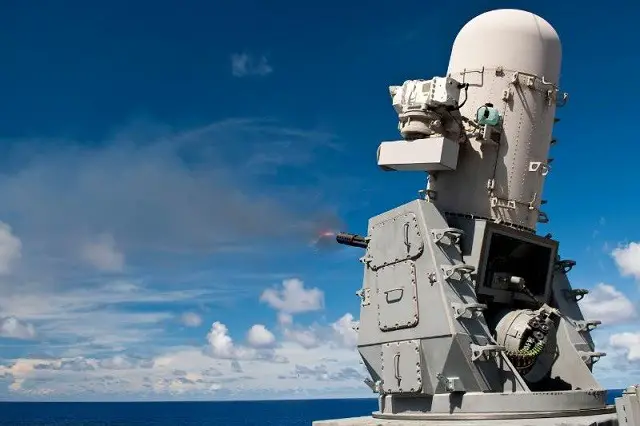
Work under the contract is expected to be completed by December 2022.
CIWS consists of 2 variants: Phalanx, which utilizes a six-barrel Gatlin gun; and SeaRAM, which replaces the gun with an 11-round Rolling Airframe Missile (RAM) guide.
Phalanx is a rapid-fire, computer-controlled radar and 20 mm gun system that automatically acquires, tracks and destroys enemy threats that have penetrated all other ship defense systems. More than 890 systems have been built and deployed in navies around the world.
Intended to enlarge Phalanx's keep-out range against evolving anti-ship missiles, rotary- and fixed-wing aircraft and other threats, SeaRAM Anti-ship Missile Defense Systems use advanced Phalanx Block 1B sensors and replaces the gun with an 11-round Rolling Airframe Missile guide. SeaRAM is aboard the Independence-class of the U.S. Navy's Littoral Combat Ships.
Friday, 05 August 2016
Raytheon Company has been awarded a $287.9 million contract modification for MK 15 Close-In Weapon System (CIWS) upgrades and conversions, system overhauls, and associated hardware. This contract combines purchases for the US Navy (36.75 percent) and for the governments of Turkey (44.09 percent) and Australia (19.16 percent), under the Foreign Military Sales (FMS) program.
Raytheon Company has been awarded a $287.9 million contract modification for MK 15 Close-In Weapon System (CIWS) upgrades and conversions, system overhauls, and associated hardware. This contract combines purchases for the US Navy (36.75 percent) and for the governments of Turkey (44.09 percent) and Australia (19.16 percent), under the Foreign Military Sales (FMS) program.
Phalanx Close-In Weapon System

Work under the contract is expected to be completed by December 2022.
CIWS consists of 2 variants: Phalanx, which utilizes a six-barrel Gatlin gun; and SeaRAM, which replaces the gun with an 11-round Rolling Airframe Missile (RAM) guide.
Phalanx is a rapid-fire, computer-controlled radar and 20 mm gun system that automatically acquires, tracks and destroys enemy threats that have penetrated all other ship defense systems. More than 890 systems have been built and deployed in navies around the world.
Intended to enlarge Phalanx's keep-out range against evolving anti-ship missiles, rotary- and fixed-wing aircraft and other threats, SeaRAM Anti-ship Missile Defense Systems use advanced Phalanx Block 1B sensors and replaces the gun with an 11-round Rolling Airframe Missile guide. SeaRAM is aboard the Independence-class of the U.S. Navy's Littoral Combat Ships.
